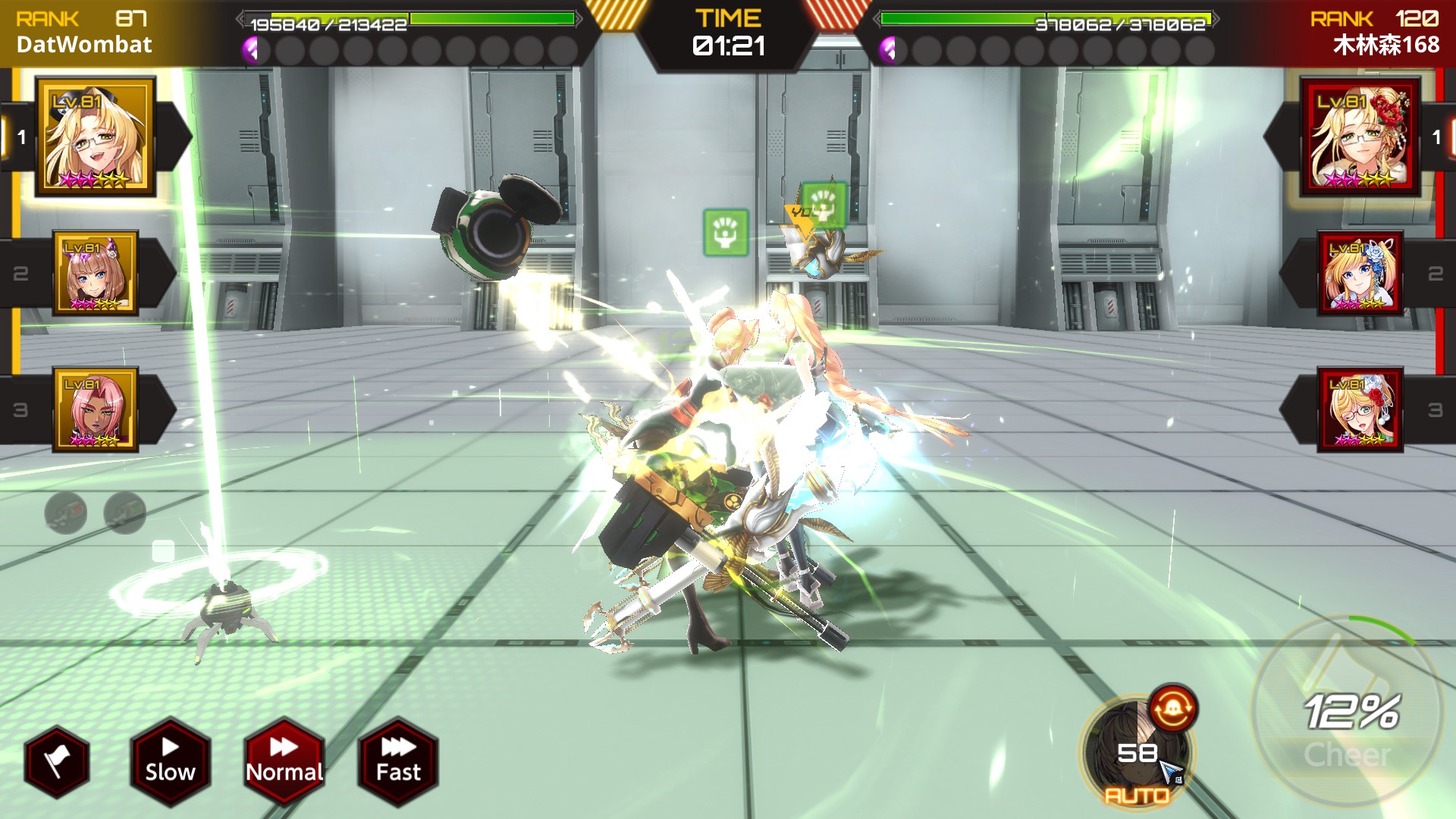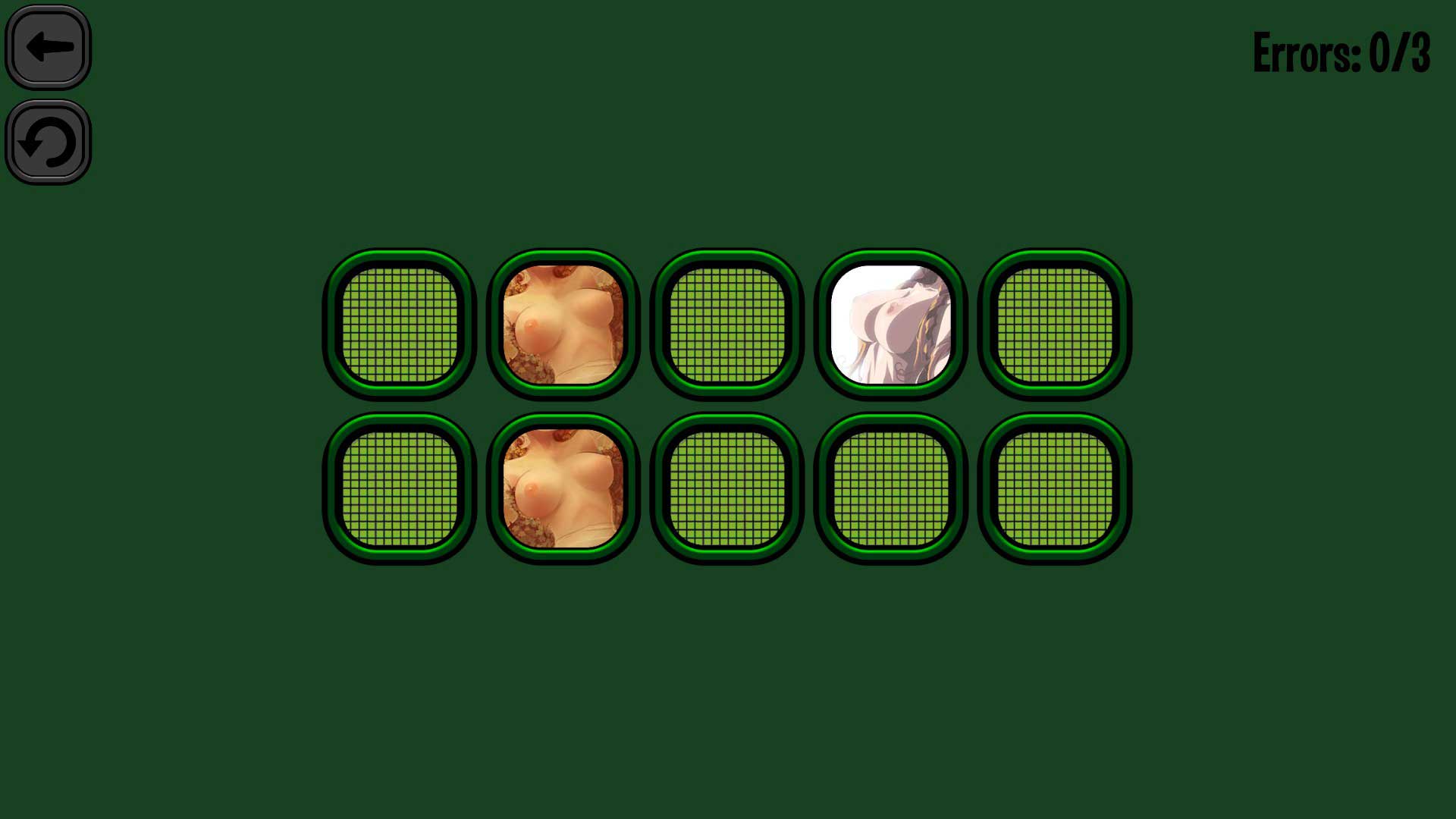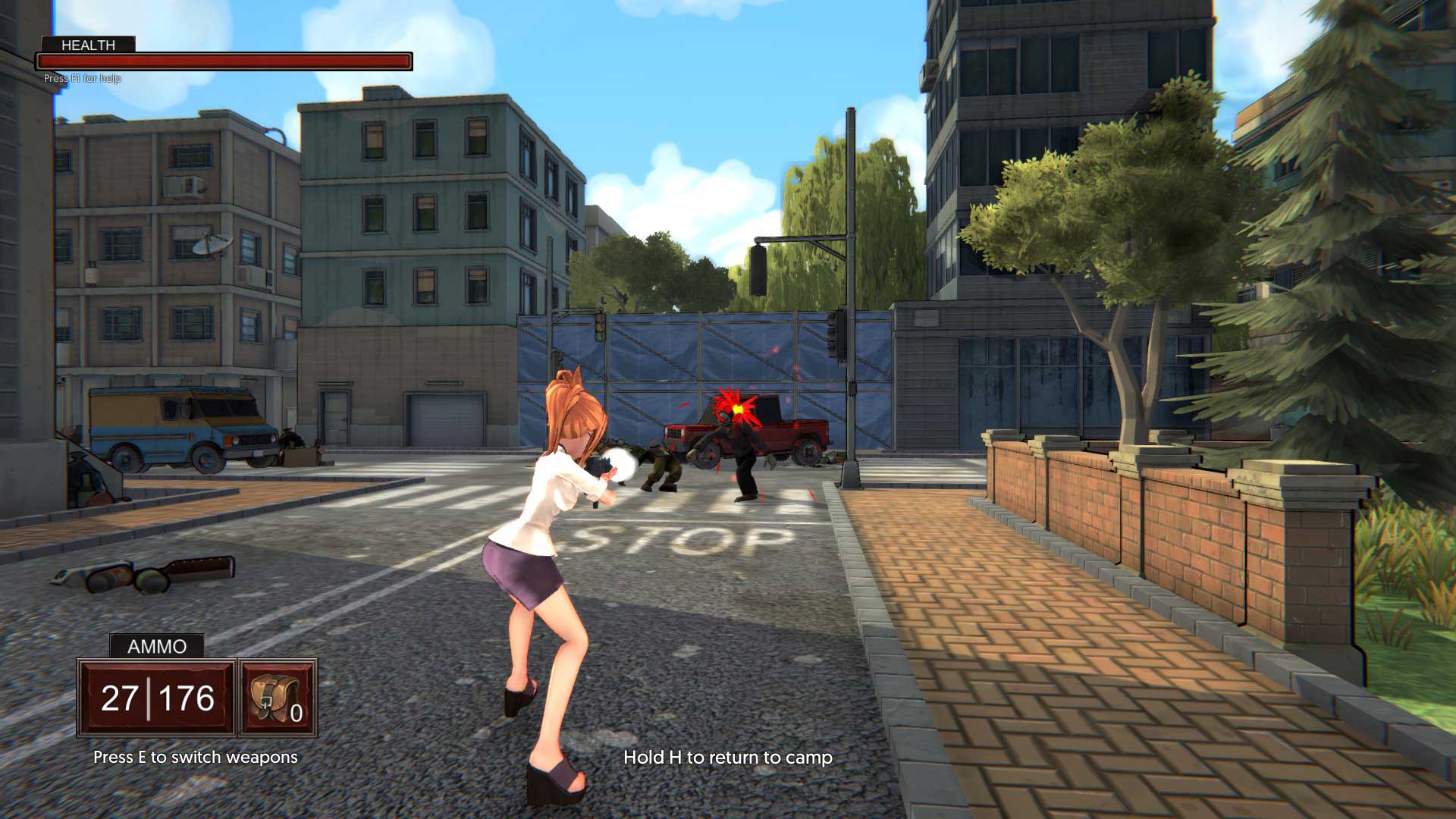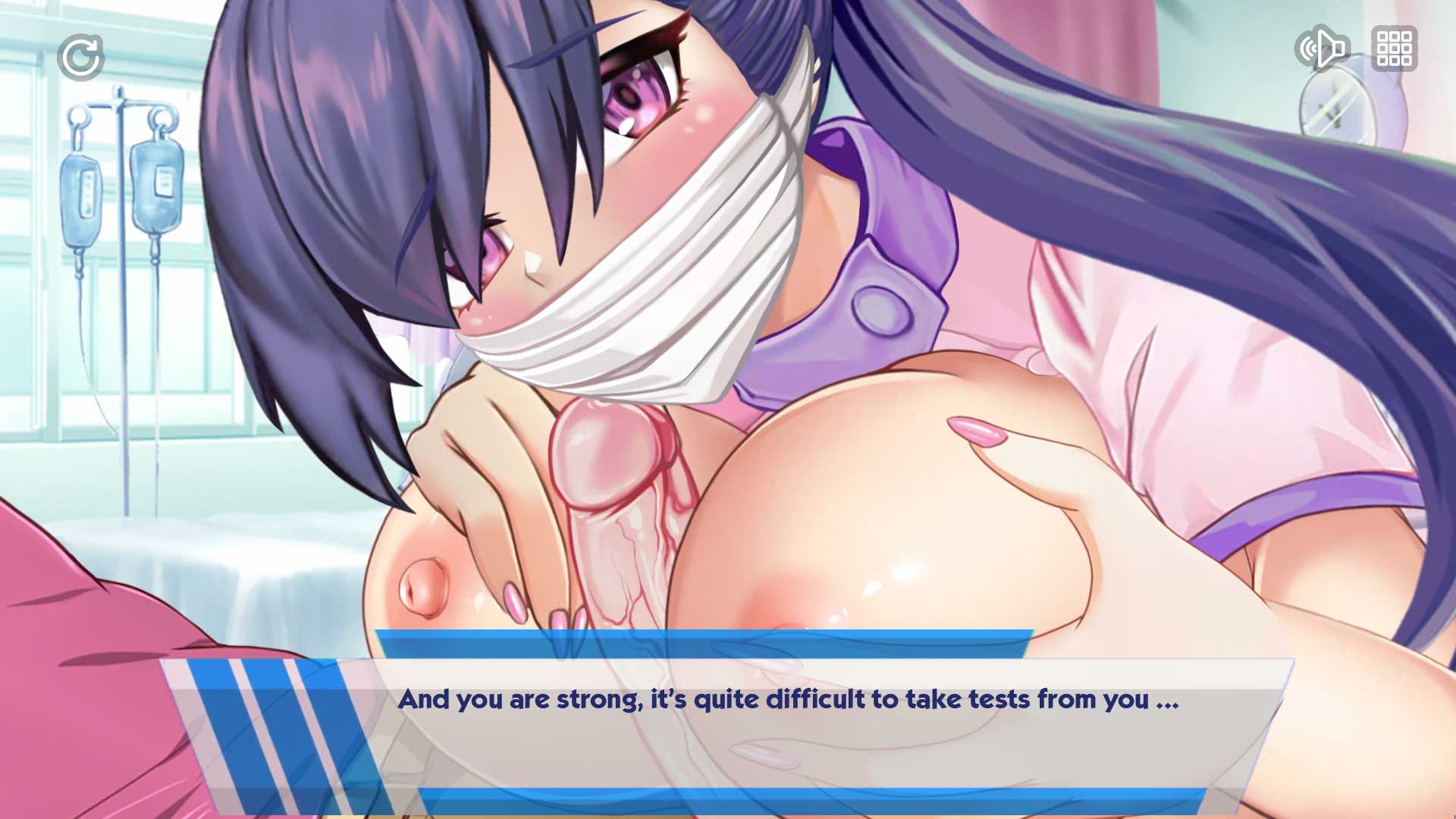Action Taimanin is a free-to-play hack-n’-slash with RPG elements and aggressive monetization.
Adult Content
Sexual innuendos.
Censorship
N/A (Not Applicable)
Adult Patch
N/A (Not Available) .
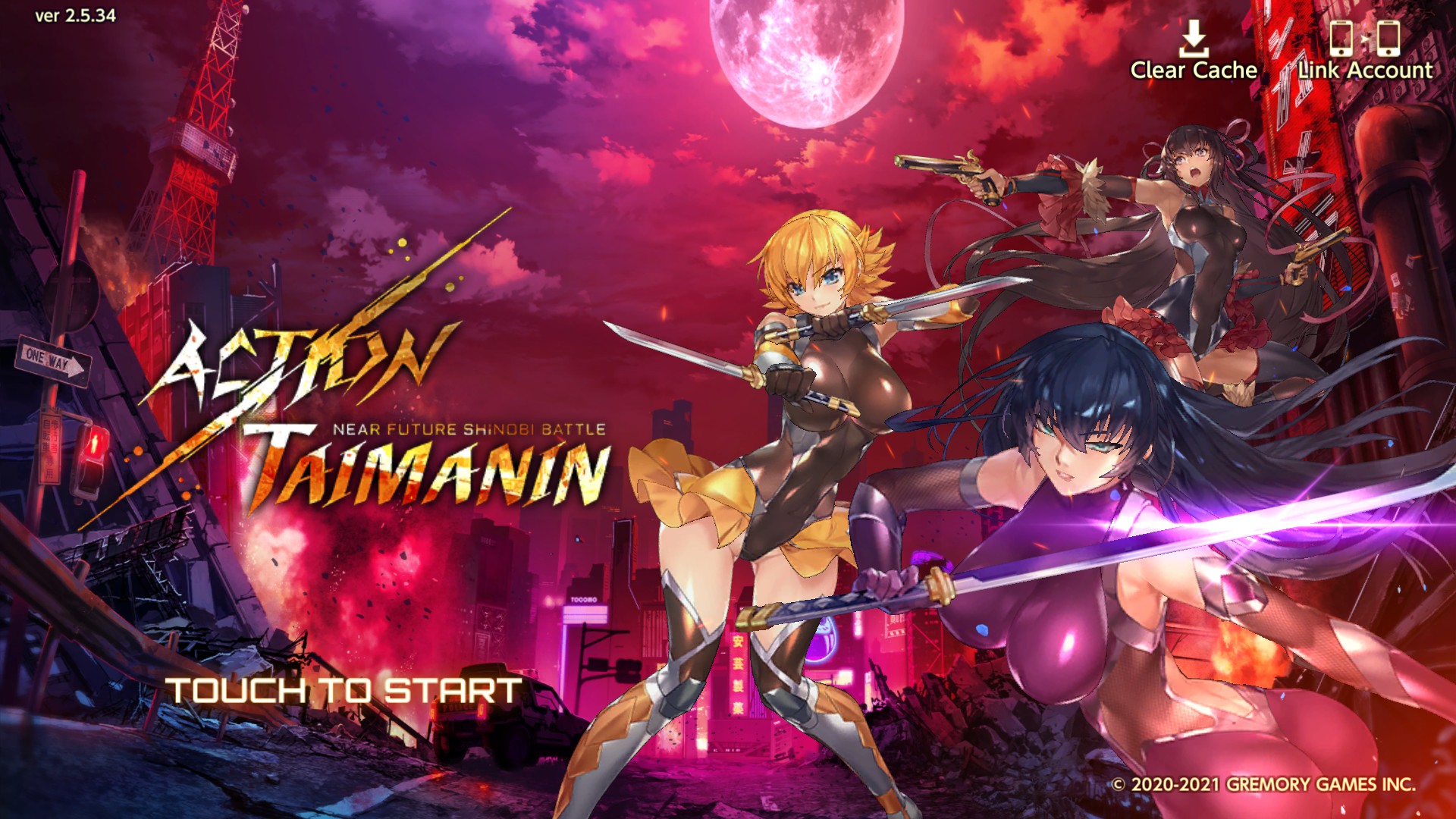
Table of Contents
Chapter I: Foreword
Chapter II: Gameplay
Section I: Pay — or Wait to Play
Section II: Taimanin, Big Tits with a Big Price
Section III: Pittance
Section IV: Battle Arena
Section V: Grind! Grind! Grind!
Section VI: Paywall
Section VII: Spend! Spend! Spend!
Section X: Gachas (or Gambling)
Section X: Mileage: Luxury Currency
Chapter III: Sexual Content
Section I: Summary
Section II: moderchan’s Nude Mods
Chapter IV: Story
Section I: Summary
Section II: Character Building
Chapter V: Sound
Section I: Voice Acting
Section II: Soundtrack
Chapter VI: Visuals
Section I: Graphics
Section II: Customization
Chapter VI: Verdict
Epilogue: Recommendations
Section I: Pricing
Section I: Invulnerability in PvP
Chapter I: Foreword
[Censored Content]
Chapter II: Gameplay (2/5★)
Action Taimanin is a grindy hack-and-slash with RPG elements. Gameplay consists of minute long “Quests” and hours of inventory management. The name of the game “grind” (or pay up!) Progression is primarily based on a gambling system, locking upgrades and limited time offers behind expensive “gachas”. If you aren’t willing to pay, then you aren’t going to play; after the introductory period, gameplay is heavily time gated.
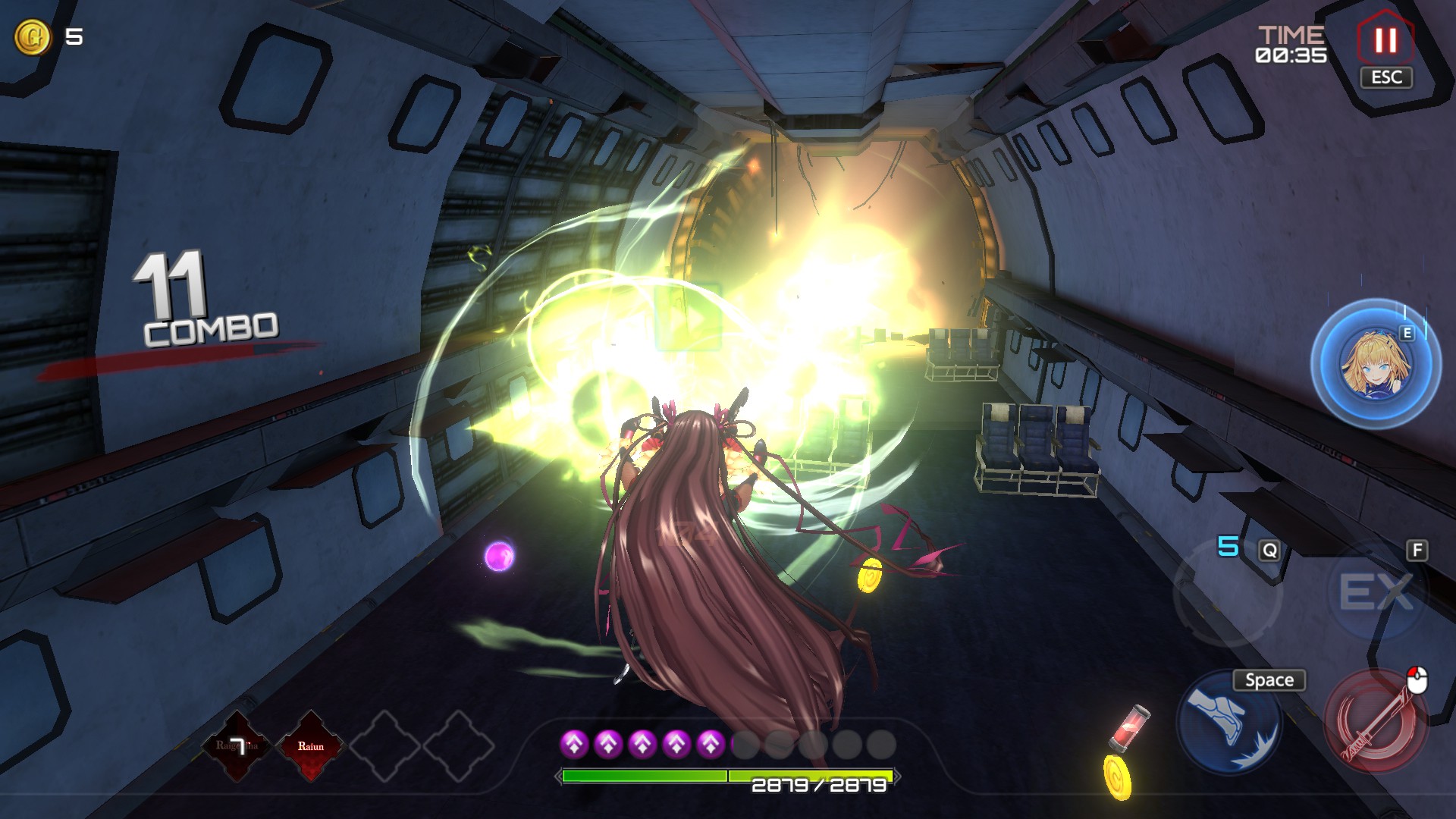
Section II: Pay — or Wait to Play
Action Taimanin employs two currencies for pay-walling gameplay, “Action Points” (or “AP”) and “Battle Points” (or “BP”). One AP is recharged every three minutes, and one BP every hour. BP is intended for PvP content, such as the “Battle Arena” and “Time Attack”. For four or more Action Points, you may play a single “Quest” (which is about a minute of gameplay). By spending up to five times the AP, you may multiply your Quest rewards — and consequently, the time you must wait to recharge AP and continue playing.
Of course, if you’re willing to pay to play, you won’t have to wait to play-. “AP Potions”, sold for for ten “Gems” (or about one USD) completely restore your AP. For the same price, “BP Potions” restore a single BP. Unfortunately, Potions are scant gameplay rewards with varying payoff. The maximum BP tied to your Action Taimanin account is capped at five, but maximum AP varies wildly between accounts. Completing a sufficient number of Quests will increase the “Rank” of your account, allowing you to store (one) extra AP. Each Taimanin you own grants an additional five AP storage, but they aren’t cheap.
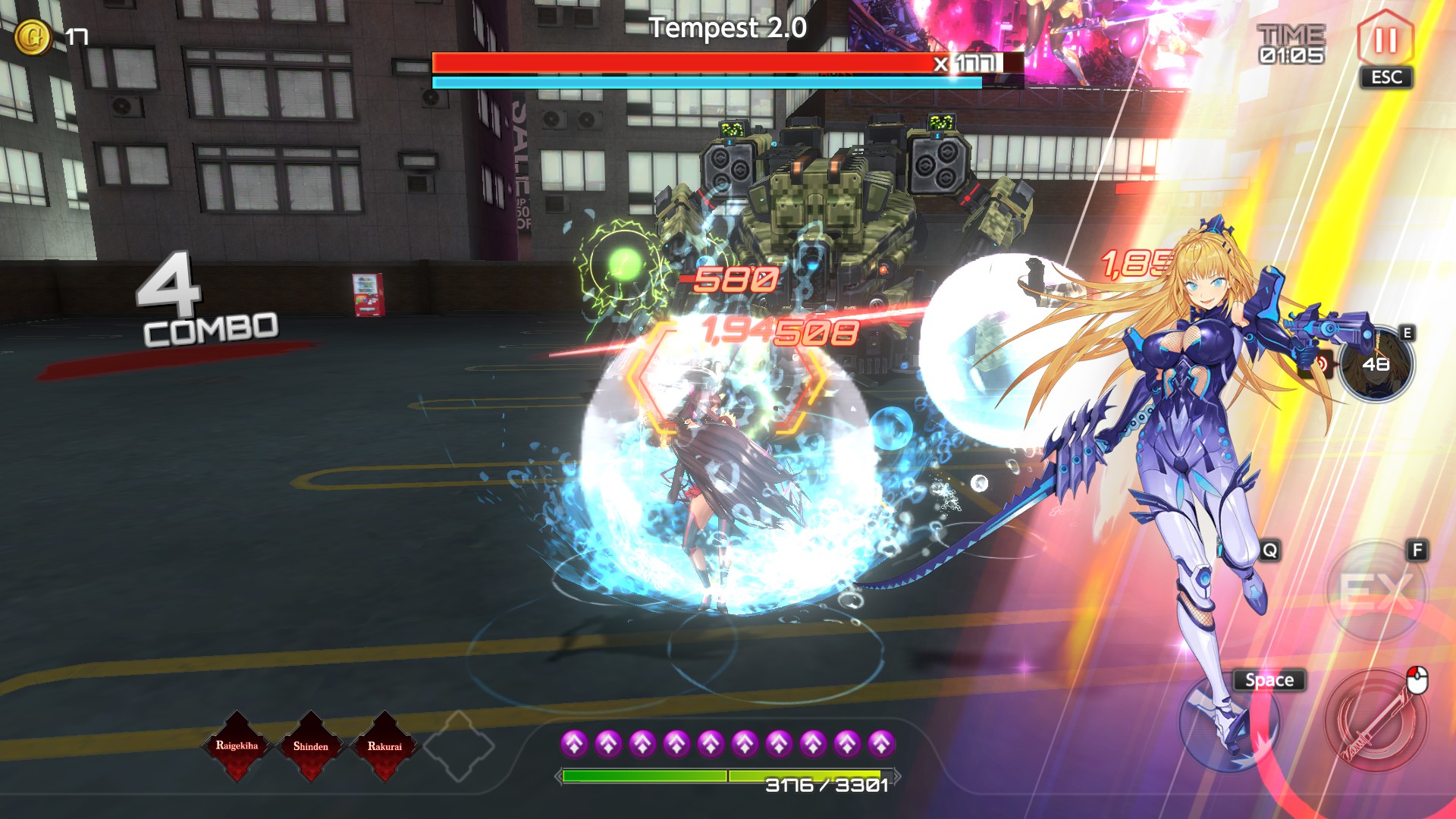
Section III: Taimanin, Big Tits with a Big Price
When you start a new account, you must choose one Taimanin from the opening cutscene; Mizuki Yukikaze, Igawa Asagi, or Igawa Sakura. After choosing a starting character, you will be informed “Other Taimanins can be recruited later.”
A more accurate disclaimer would read, “Other Taimanins can be purchased later.”
To “recruit” new Taimanins, you’ll have to pony up at least 800 Gems, or as many as 1,200 each. Taimanins may also be acquired as part of “Character Packages” starting at forty-five dollars. The price of Gems vary by offer, ranging between 1.8 and ten cents each. Gems are a premium currency which may be purchased or earned piecemeal by completing assorted objectives. However, saving enough to buy just one new character is a test of frugality that takes place over months of religious gameplay.
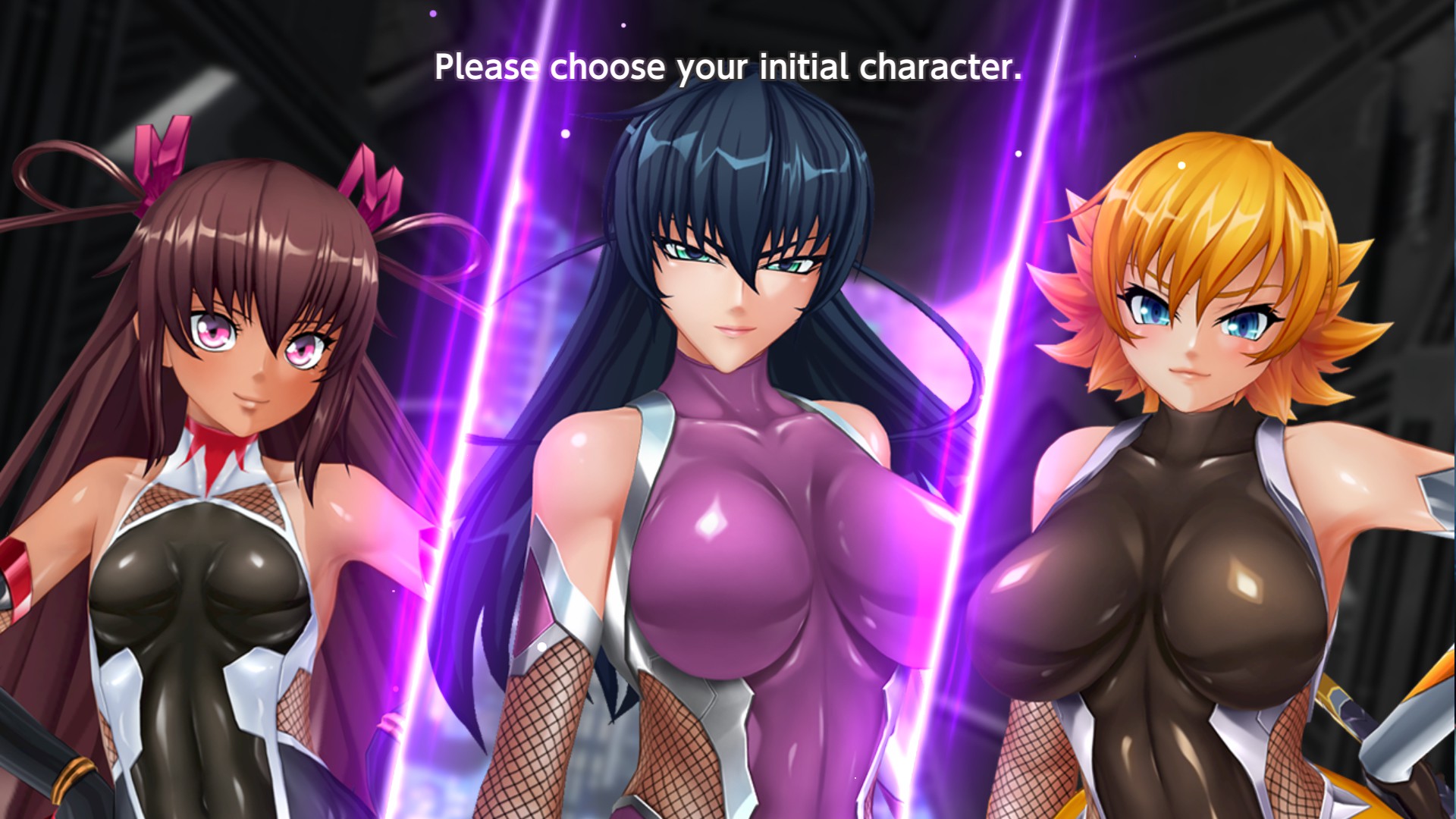
Section IV: Pittance
Each Quest offers a one time reward of ten Gems if up to three “Challenge Objectives” are completed. They include avoiding damage, speed of completion and racking up “combos”. If you were to complete all Challenge Objectives for all Quests at every difficulty level, you would collect enough Gems to buy only two new Taimanins. Such a task would take most players at least ten hours (significantly more should “Hard” Quests prove too difficult).
There are a few other ways to collect free Gems, but they take days instead of hours to see any returns. Between the “Weekly Mission” and “Login Bonus”, you’re able to collect around eighty Gems every seven days with little effort. Fighting rival players in the “Battle Arena” can award up to 300 Gems a week, but only if your teams lands first place globally. Realistically, the Battle Arena will award most players no more than seventy-five Gems per week — but only if you own a team of competitive, high-level Taimanins!
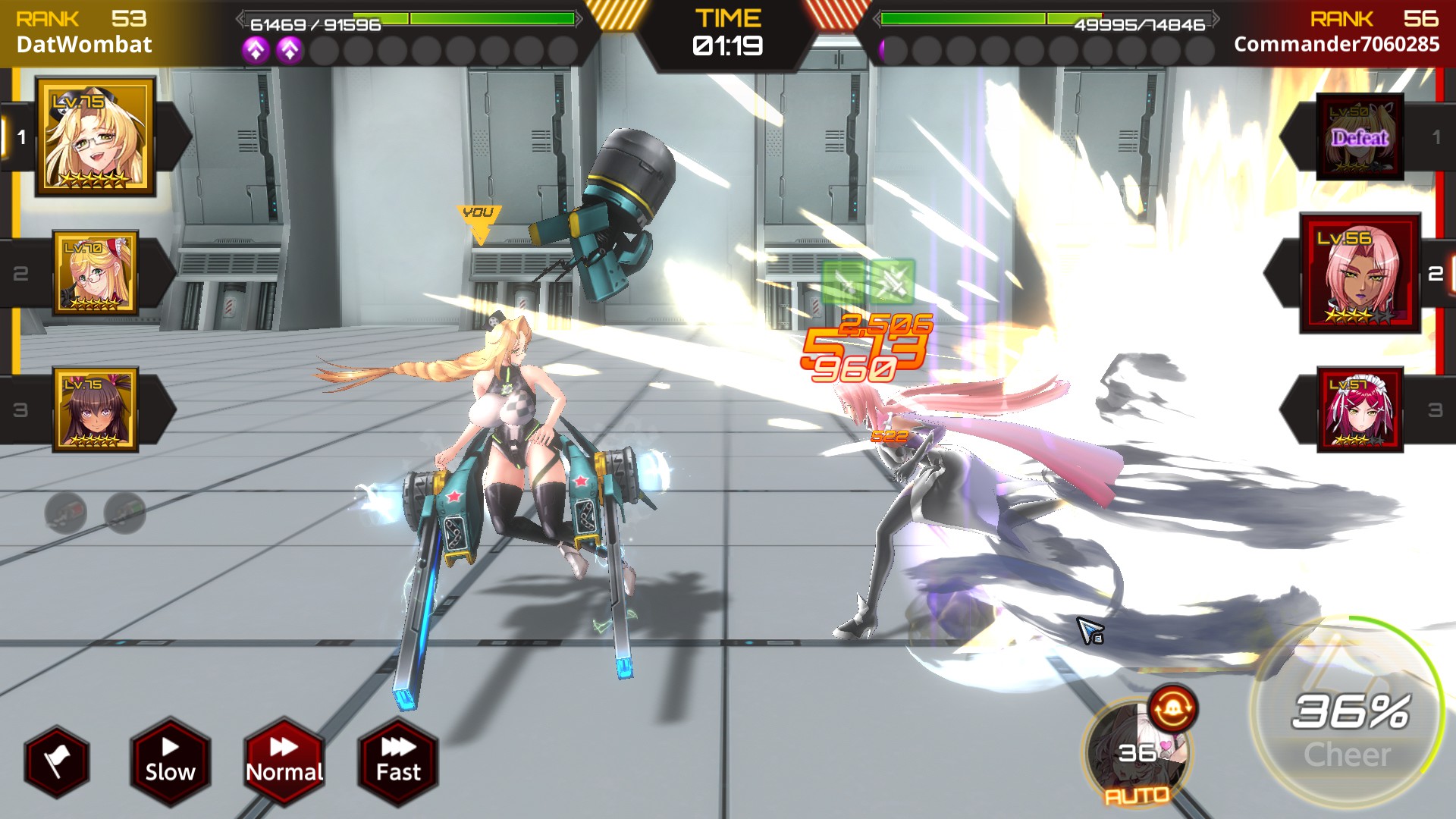
Section V: Battle Arena
The Battle Arena is a game mode for battling rival players. Defeating rival Taimanin will increase your “rank”, which determines the strength of your opponents and weekly rewards. Win or lose, you’ll earn some “Arena Coins” at the end of the battle. They are mainly for purchasing items tailored to PvP, including exclusive weapons and equipable “Crests” to buff your team. Battle Arena is a wonderful change of pace from mainline (PvE) content, but balancing and player agency leave a lot to be desired.
Combat between Taimanins is automated; attacking players may only activate Supporters or provide a random boost in the form of a “Cheer”. Although players are allowed teams of three, fights are strictly one-versus-one. Taimanins can’t be “swapped” or provide any form of assistance to each other during battle. Fights take place on flat 2D plane, probably to facilitate quick results. Taimanins only perform basic instructions; melee characters charge and swing, and ranged characters stay put and shoot.
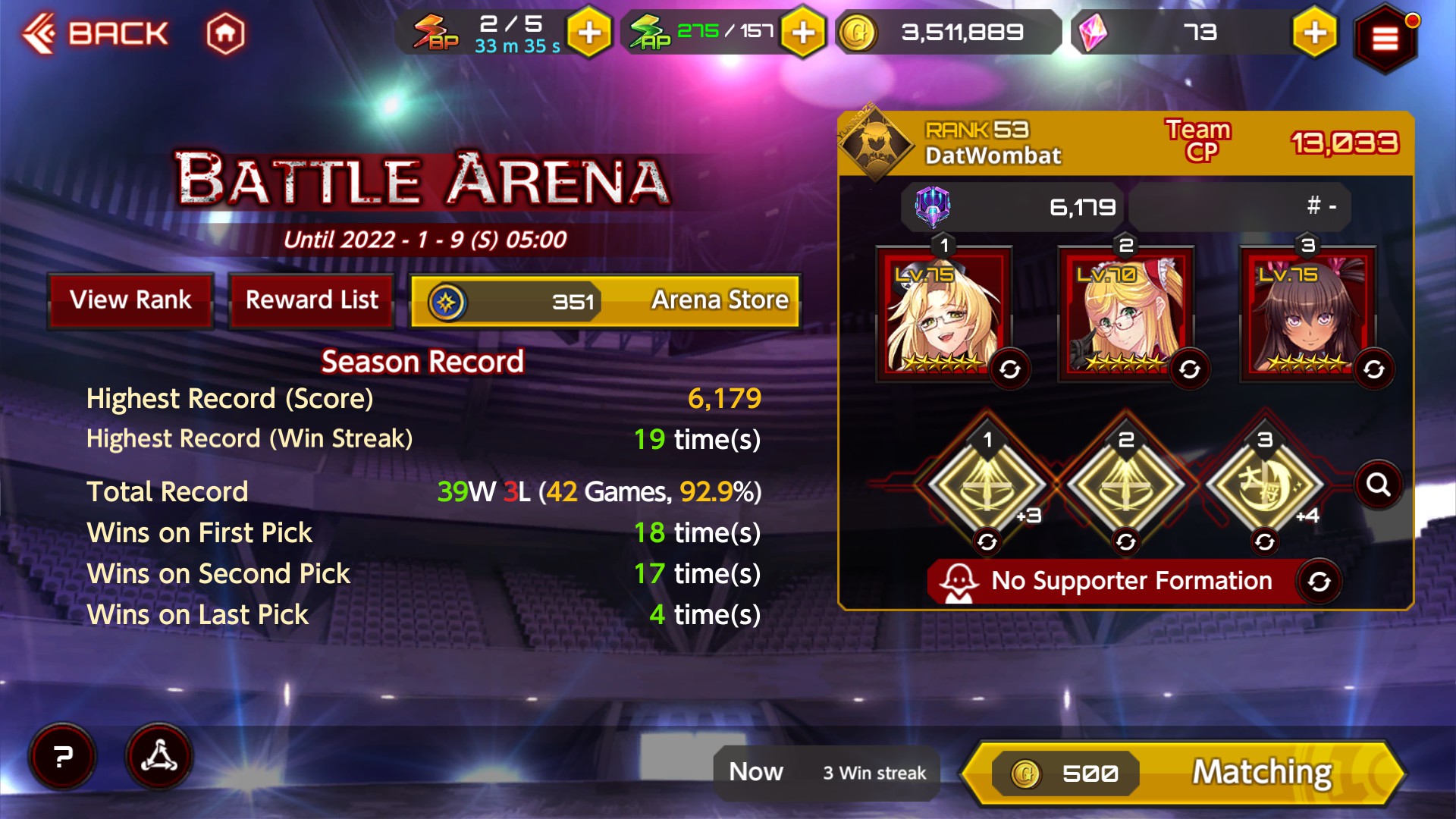
It’s still fun to watch Taiminins fight, but PvP wasn’t designed with balance in mind. Teams that are able freeze and your Taimanins again and again are the norm. The meta is dominated by a handful of Supporters granting up to sixteen seconds of invulnerability. The Arena Shop offers weapons that deal double damage to Taimanins, insuring no other weapon has a place in the meta. Even before encountering these weapons, the outcome of battle will always favor the player who spent more money on Gachas.
The matchmaking for Battle Arena is a shit show. When I started with low-level Taimanins, my battles were relatively balanced against new players. But once I Ascended my first Taimanin, she alone steamrolled every team — no matter how many matches I fought, the Battle Arena refused to pair my fighters with equal strength opponents. I ended up building weak Taimanins to prevent my team from ending fights too fast.
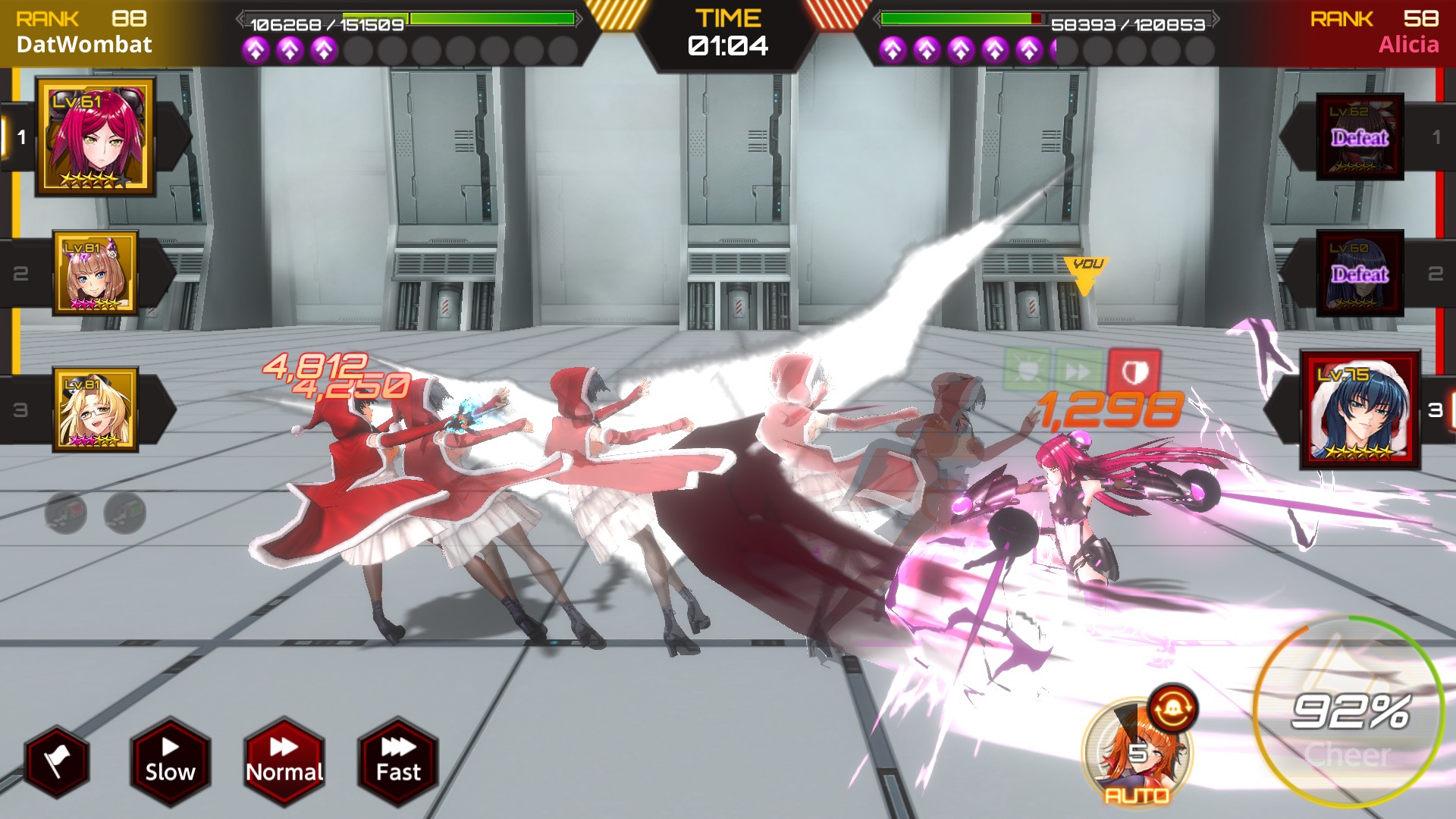
Section VI: Grind! Grind! Grind!
Taimanins grow stronger by completing Quests to collect “Experience” to gain “Levels”. Once a Taimanin reaches the maximum number of Levels, she is forbidden from collecting additional experience until she is “Promoted”. Promotions consume “Gold” and assorted “Materials”, both of which common quest rewards. As promotions increase in price, it’s necessary to grind a specific collection of Quests: “Daily Quests”.
Daily Quests are four, unchanging Quests that constitute most grinding in Action Taimanin. Unless you’re completing Challenge Objectives or limited time “Event Quests”, there is no reason to spend AP on anything but Daily Quests. I spent hundreds of hours completing the four Daily Quests — specifically the “Gold Quest” to pay the exorbitant fees tied to upgrading everything. Daily Quests aren’t just for Taimanins; all equipable items have at one mechanic analogous to the Promotion system.
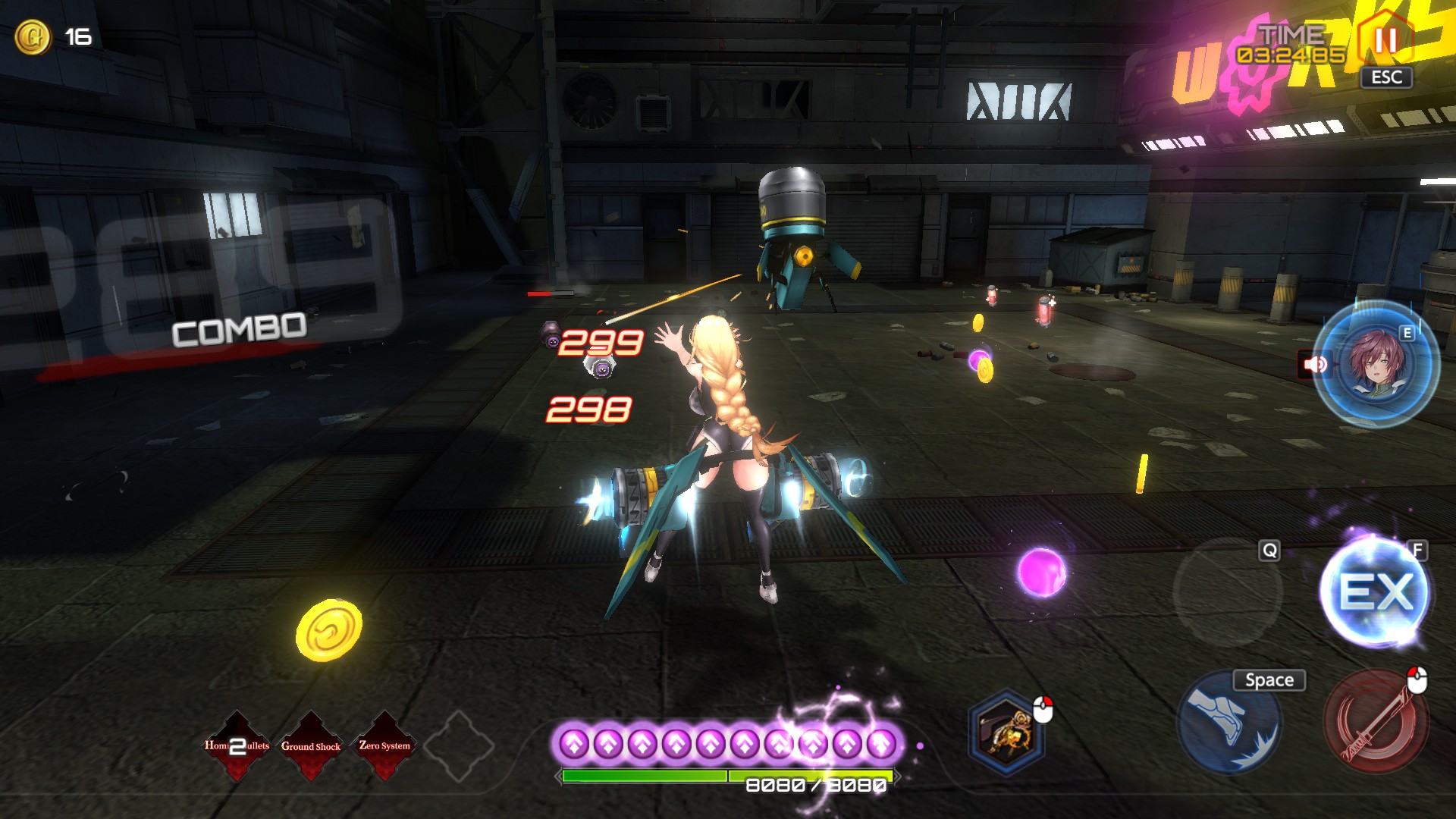
Section VII: Ascensions
Taimanins may be Promoted up to five times — then, they must instead be “Ascended”. There are no reasonably paced, non-paying solutions for acquiring the necessary Materials. The most straightforward method is to climb the “Arena Tower”, a difficult slog of Quests intended for a team of already Ascended Taimanin. If you’re unwilling to pay for Ascensions, you may instead spend a few months grinding aggressively.
Fortunately, Ascensions aren’t necessary to unlock any cutscenes or dialogue. But once your Taimanins are able to breeze through Quests on “Hard”, Action Taimanin goes stale. There simply isn’t any content to bridge the gap between Hard Quests and the frustratingly difficult Arena Tower. If you try (and I mean really try) to Ascend Taimanins the “intended way”, the process is around two to three months per Ascension, RNG willing.
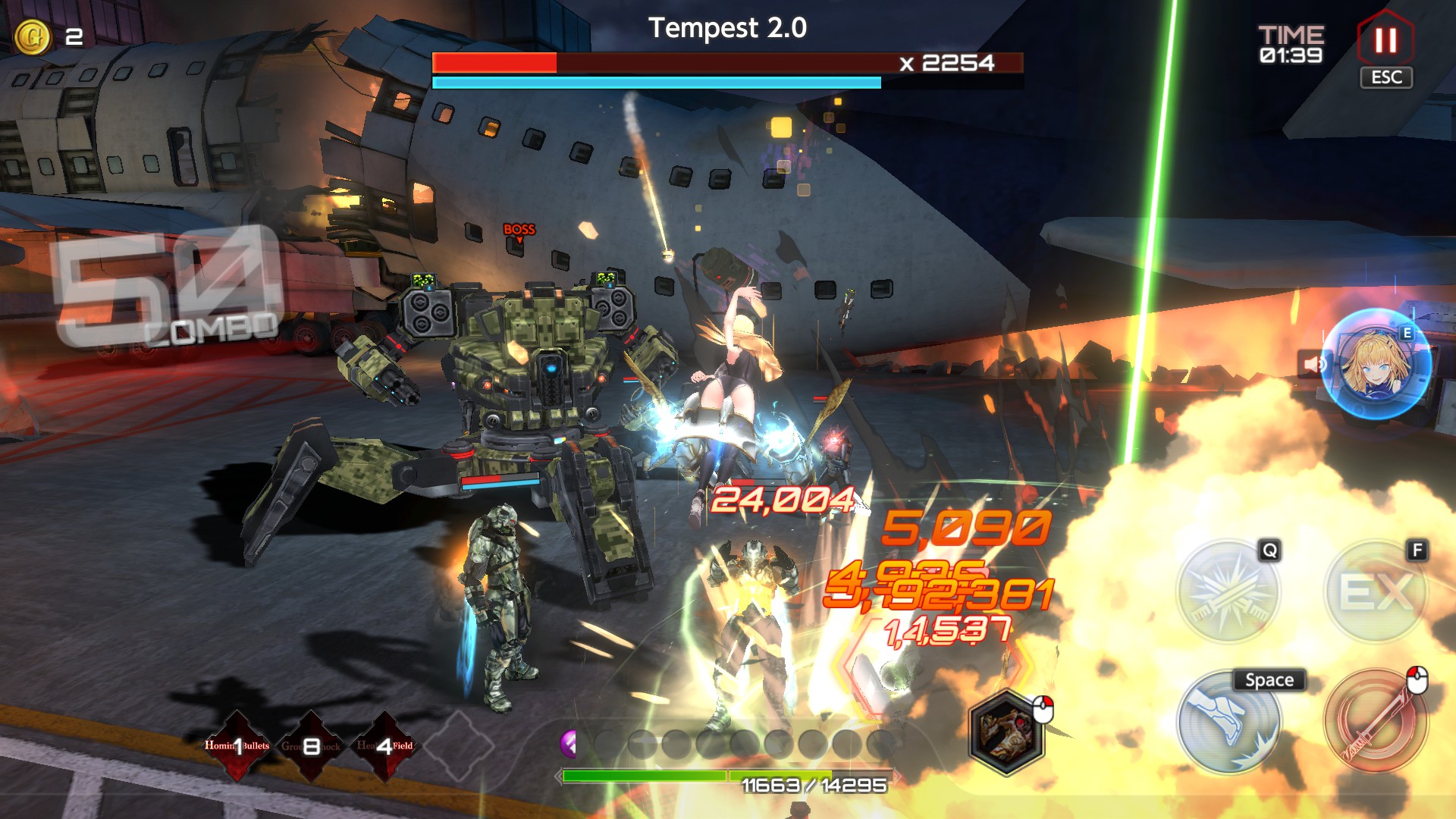
First, I’ll discuss the acquisition of “Shards”.
As long as you own at least one high level Taimanin, each Shard is two or three weeks of daily PvP. Before Shards are available for purchase, your team must reach “Top Rank” by defeating a sufficient number of high ranking teams. Upon doing so, you may purchase up to one Shard per week for 15,000 Arena Coins.
15,000 Arena Coins is equivalent to 357 wins (or as little as 190 if you pay 5,000 Gold per battle to double your earnings). By combining the weekly payout of Top Rank (or 3,200 Coins) with at least twenty-two wins per day, it’s possible to earn 15,056 Arena Coins per week — however, without purchasing BP Potions to restock Battle Points, weekly Shards are only possible if you’re willing to sleep for less than six hours a day.
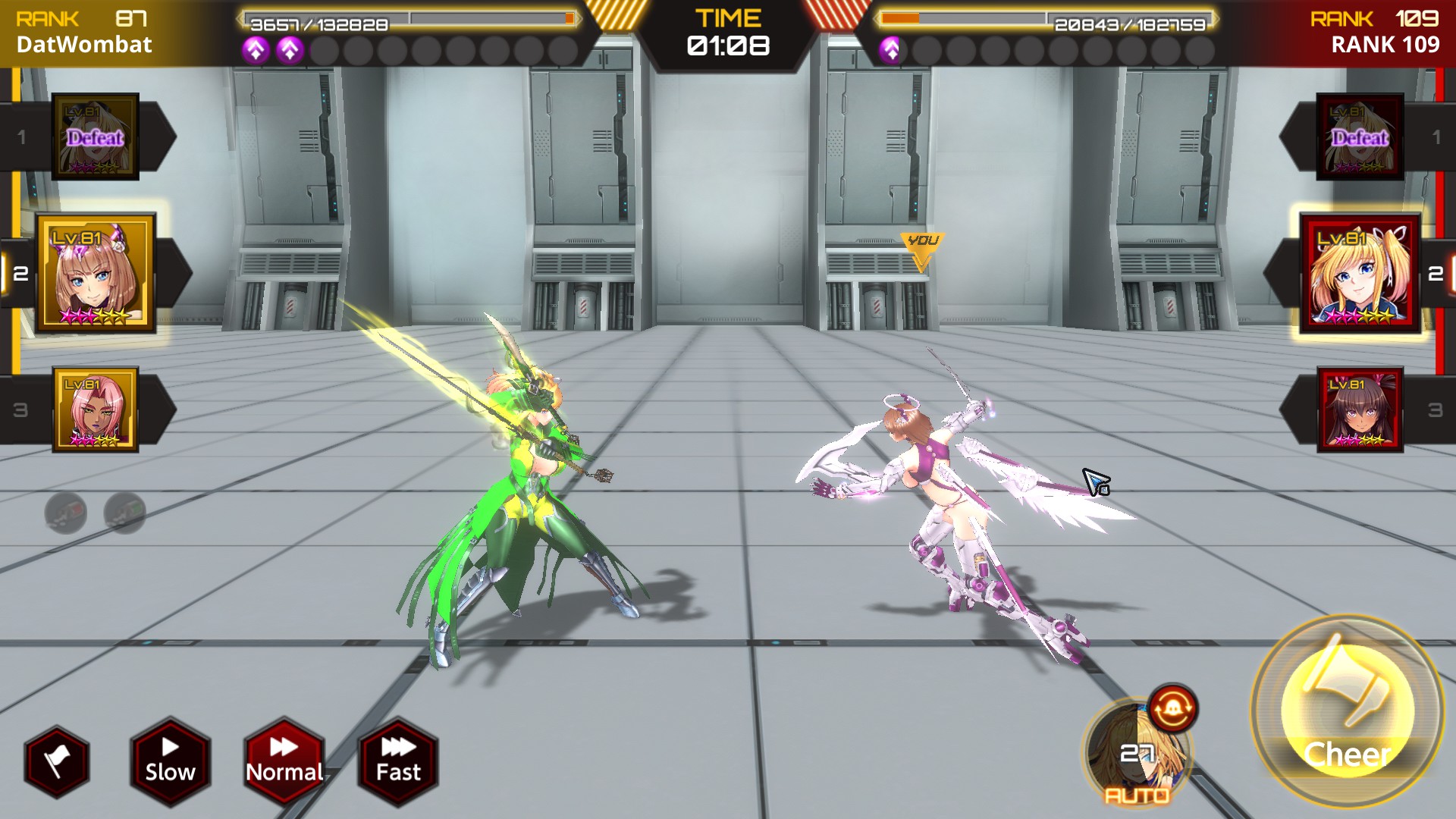
Now I will discuss Friend Emblems; unlike Shards, their acquisition is determined by RNG.
By adding other players as “Friends”, you may send and receive a daily sum of “Friend Points”. Friend Points can be exchanged for three “Friend Boxes” a week. Friend Boxes have a chance to contain up to three randomized Friend Emblems. As new Taimanins are added to the game, Friend Boxes are destined to lose effectiveness.
Alternatively, you may collect five Friend Emblems of your choice by exchanging a sufficient number of “Gifts” with owned Taimanins. Gifts of varying effectiveness are dropped from “Doki Doki Packages”, either “crafted” from Materials or randomly collected from the “Gold Gacha”. Regardless, thousands of Action Points must be expended on Daily Quests to garner the necessary Gold and/or Materials. If you’re not careful, Gifts can halt account progression by hogging Gold and Materials needed for leveling up.
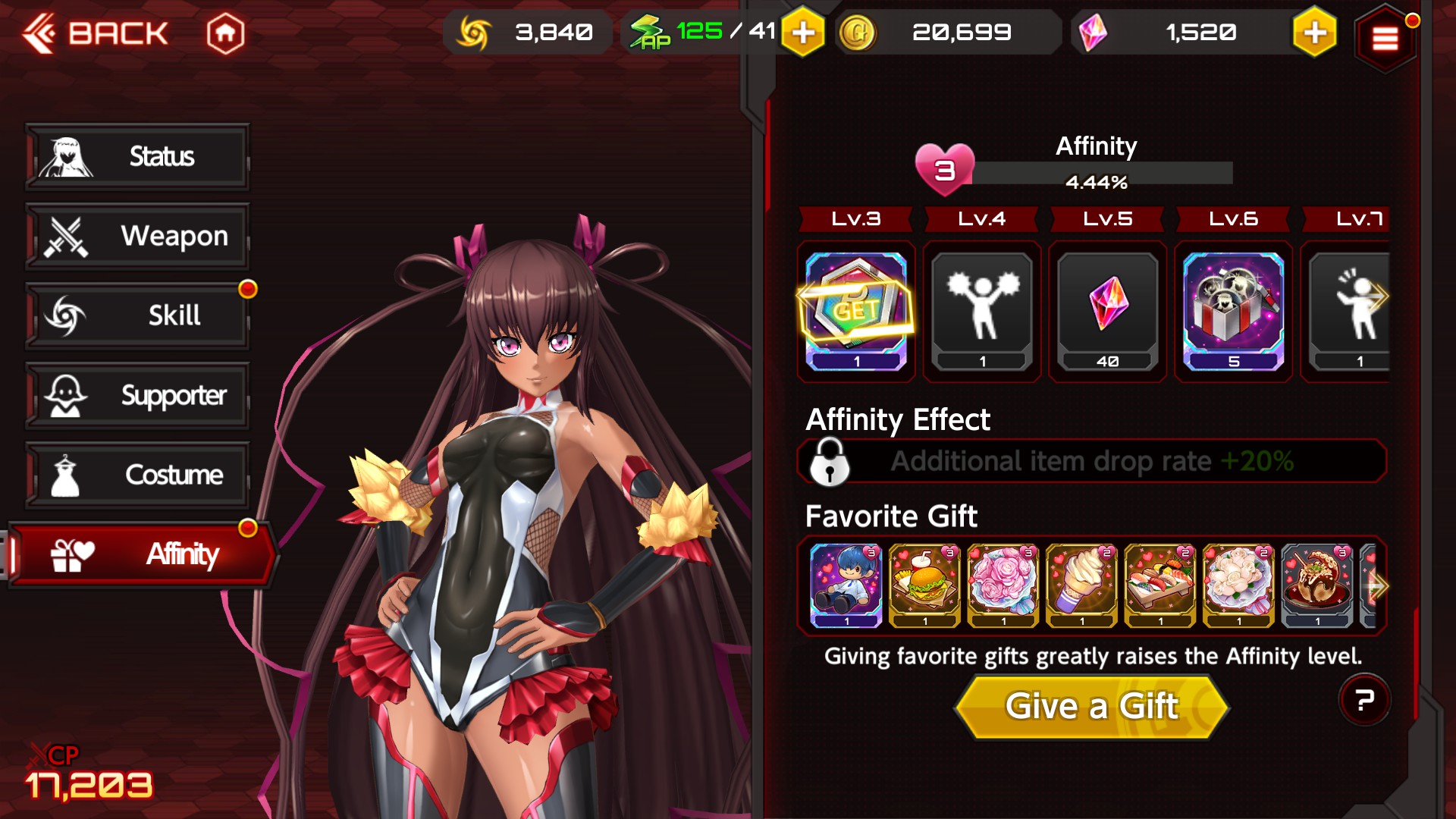
Section VIII: Spend! Spend! Spend!
Grinding in Action Taimanin is for poor people! The “Commander Jump Start Package” includes everything you need to fully Ascend a Taimanin — provided you purchase all five of them (totaling 120 dollars). Alternatively, there’s the “Monthly Awakening Pack”, good for one Ascension (for thirty dollars). Or instead, whenever a Taimanin reaches max level you may purchase a “Level Achievement Package” within the next three hours.
No, LiLith is not above “fear of missing out” (FOMO) offers to extort your money.
Level Achievement Packages provide most, if not all Gold and Materials for a single Promotion or Ascension. They also offer a week of double experience and lots of AP Potions for restoring Action Points, propelling your Taimanin into the next level cap (and consequently, FOMO offer.). Additionally, Level Achievement Packages are the most cost-efficient source of Gems in the game. If you are interested in purchasing a new character or gambling on “Gachas”, there’s no better way to buy some Gems.
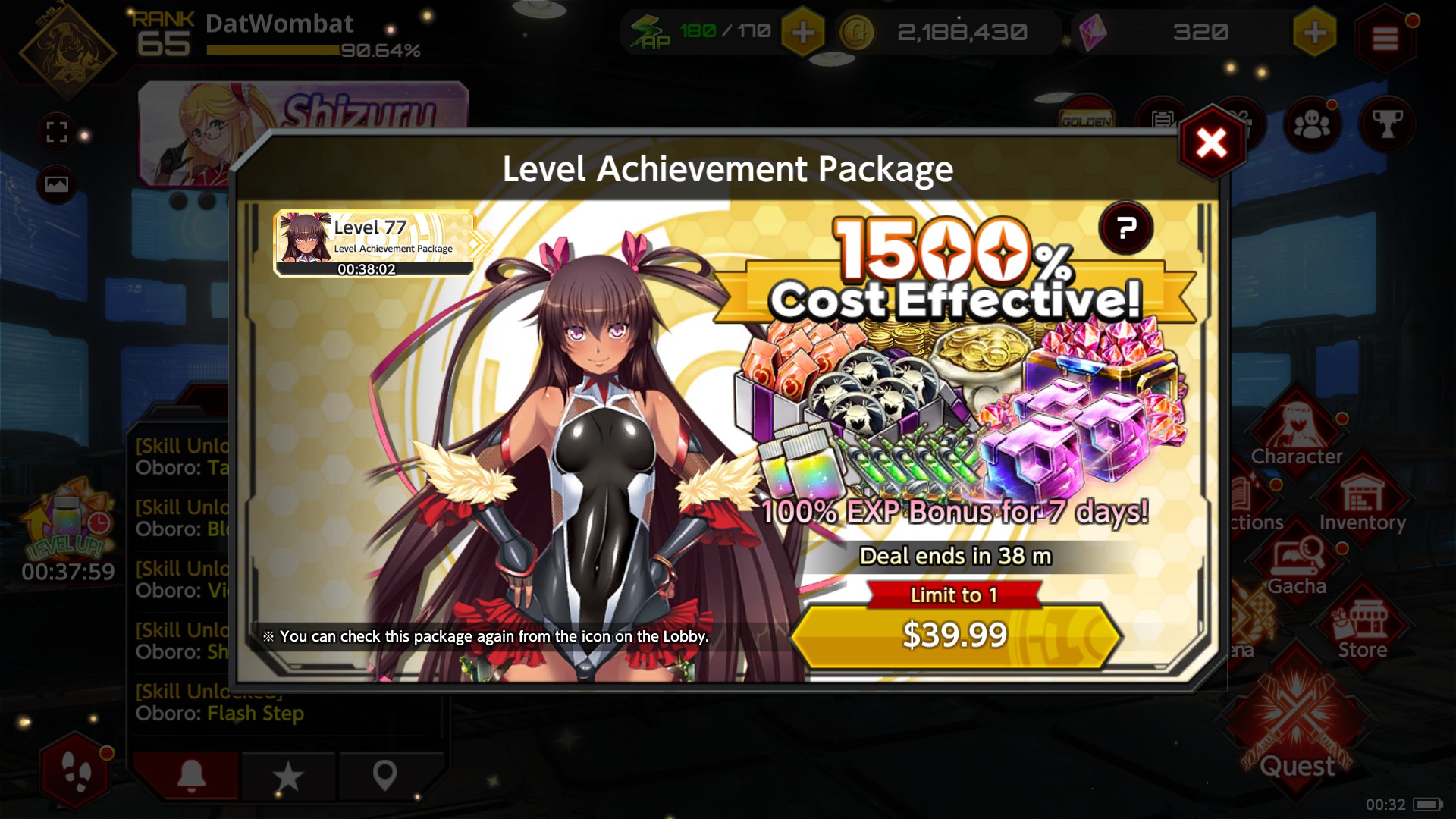
Section IX: Gachas (or Gambling)
Taimanin gain most of their power from equipping “Weapons” and “Supporters”, both of which primarily sourced from “Gachas”. Gachas offer random items of random rarity for forty or fifty Gems a piece. Rare items are more powerful than common alternatives. Ultimately, when all Quests have been completed Action Taimanin devolves into an expensive gambling game for coveted “Ultra Rares”.
Taimanins are only able to equip one kind of weapon. As a result, the less Taimanins you own the less you benefit from Gachas. If you only own one Taimanin, there’s a roughly 94% chance any weapon acquired from a Gacha is unusable. Imagine, paying for weapons you can’t even use! Making matters worse, to reach the full potential of Weapons and Supporters you must acquire five exact copies. With drop rates as little as 0.03%, acquiring five of anything rivals the cost of upgrading your PC (or a used car!)
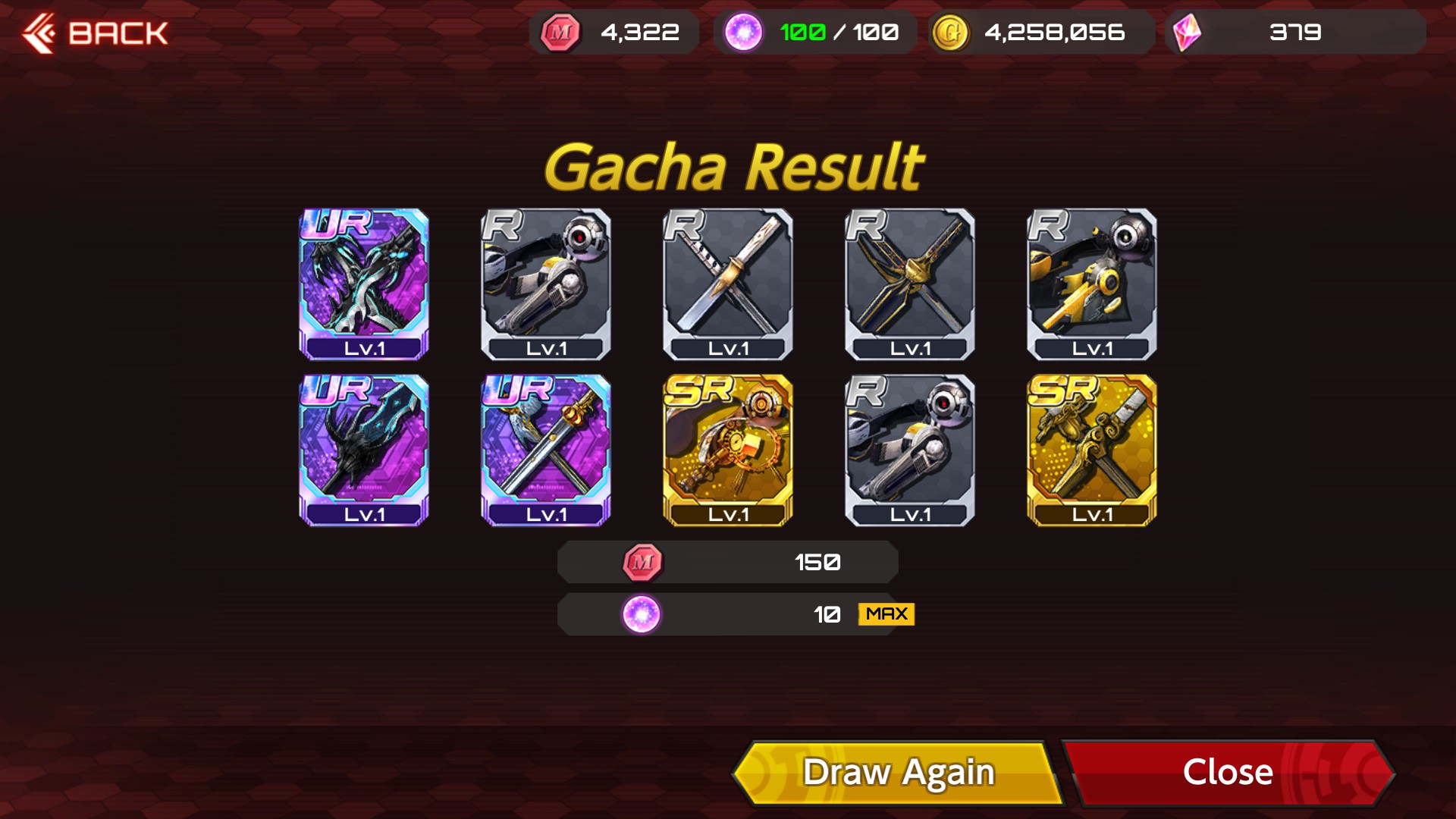
Section X: Mileage, Luxury Currency
In addition to randomized loot, Gachas provide “Mileage”, a currency for the highest spending players. Mileage is spent in the “Mileage Shop” in exchange for exclusive Weapons and Supporters. Bizarrely, a few “Bars of Gold” cost 500 Mileage, equivalent to spending at least 2000 Gems on Gachas. You can earn the same Bars of Gold in about forty seconds completing Daily Quests.
It’s heartbreaking to think of the players who’ve fallen for this beginner’s trap.
Weapons are valued at 10,000 Points, equal to at least 670 pulls or 33,500 Gems. The most expensive item in the shop costs 15,000 Mileage Points — that’s at least 1000 Gacha participations with a total value of 50,000 Gems. Depending on where you buy your Gems, 50,000 Gems can cost over three grand (I shit you not!)
Don’t get me wrong, Amamiya Shisui is a great Supporter — but so is a RTX 3090!
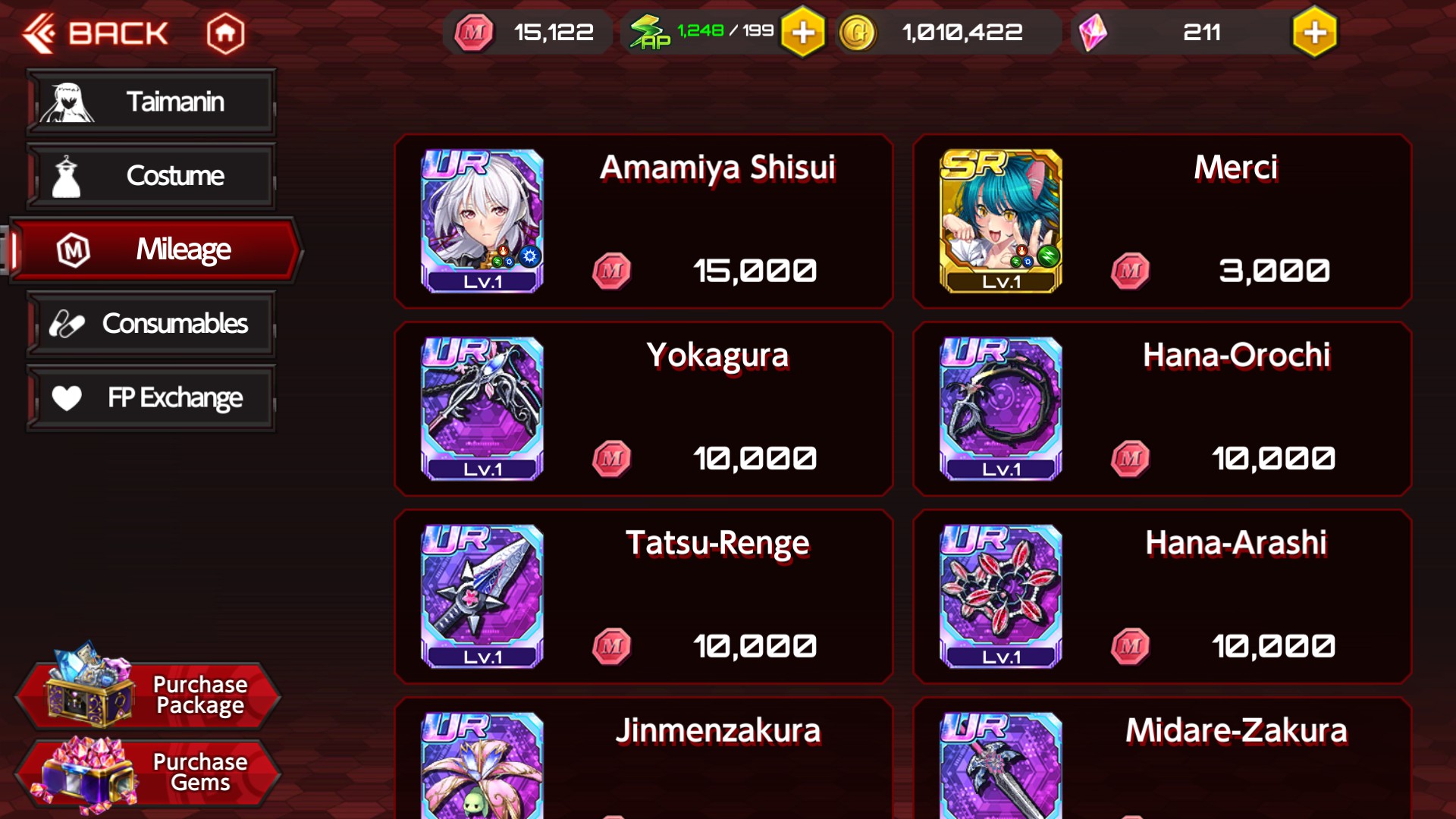
Chapter III: Sexual Content (NA/5★)
There is no nudity or sexual content in this game. This may come as a surprise — Action Taimanin stories are usually dark and depraved fantasies. Some costumes leave little to imagination, but you’ll have you’ll to settle for bare ass cheeks and form-fitting suits. Using the “Private Room”, I’ve seen players create a sort of crude erotica by photographing owned Taimanins in provocative positions.
But like everything else in Action Taimanin, it’ll cost you.
You’d think simply owning Taimanin would be enough to use them in the Private Room, but no — owning Taimanin just gives you the option to purchase them again. You’d also think purchasing Taimanin again would unlock owned costumes and facial expressions. Outfits are counted as separate, purchasable Taimanins — and each facial expression for each Taimanin (or outfit) costs as many as ten bucks in Gems!
Section One: How to Install the (unofficial) Nude Patch
Please consult my guide on modding Action Taimanin.
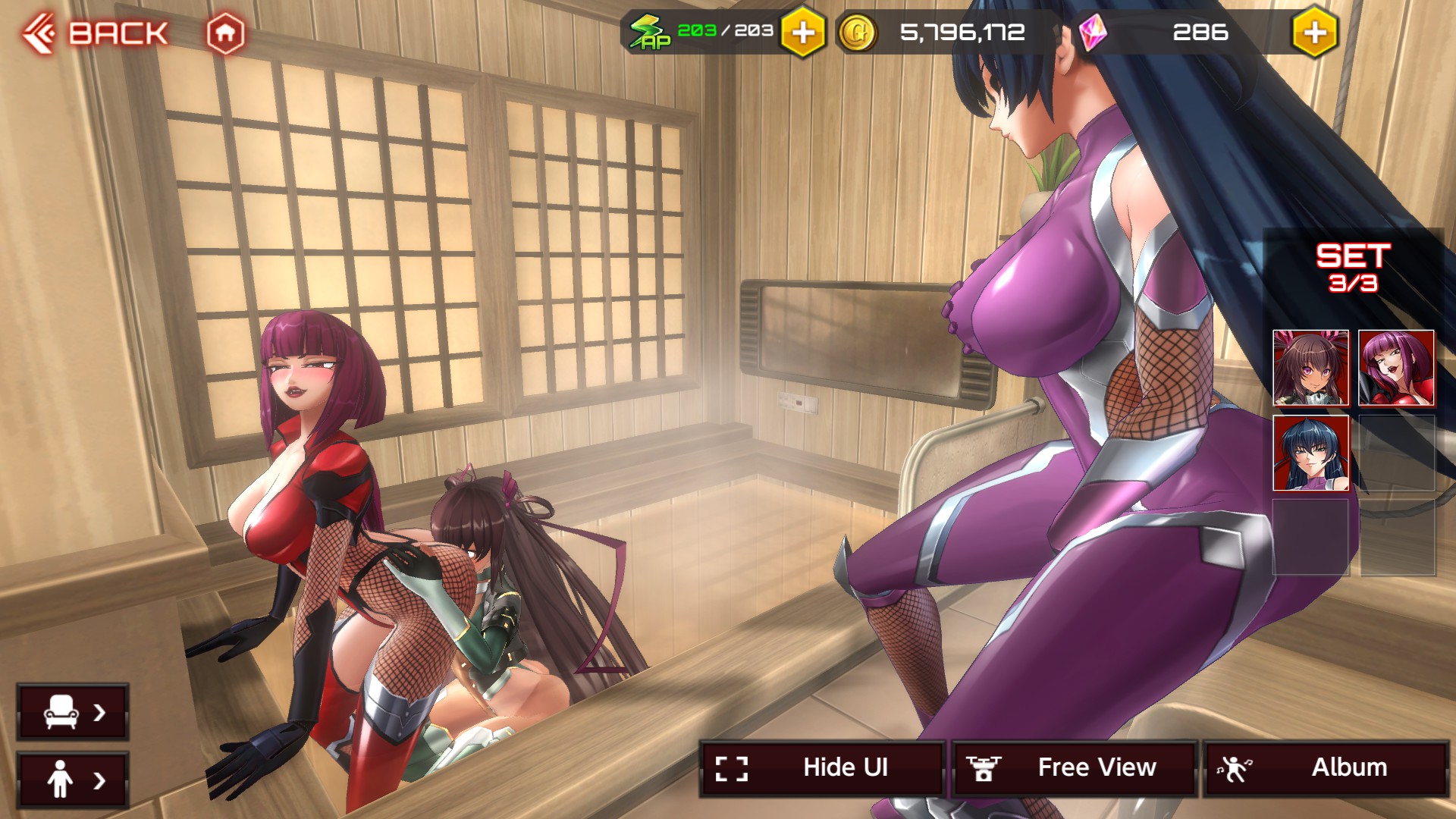
Chapter IV: Story (4/5★)
Section I: Synopsis
Fuuma Kotaro, head of the fallen Fuuma Clan has been appointed Task Force Commander of the Japan’s newest Taimanin Squad. Taimanins are master ninjas deployed by government entities as a form of special forces. Turned by promises of autonomy, wealth and power, some are swayed by demonic influence — as is the case for Momochi, the main antagonist. Momochi intends to “liberate the world from the UFS and the Chinese Union”, ushering a new world order by uprooting the largest nations in the world. Backed by the largest terrorist organization in the world, Nomad, it’s up to fledgling Commander Fuuma to thwart Nomad’s latest scheme to take over the world!
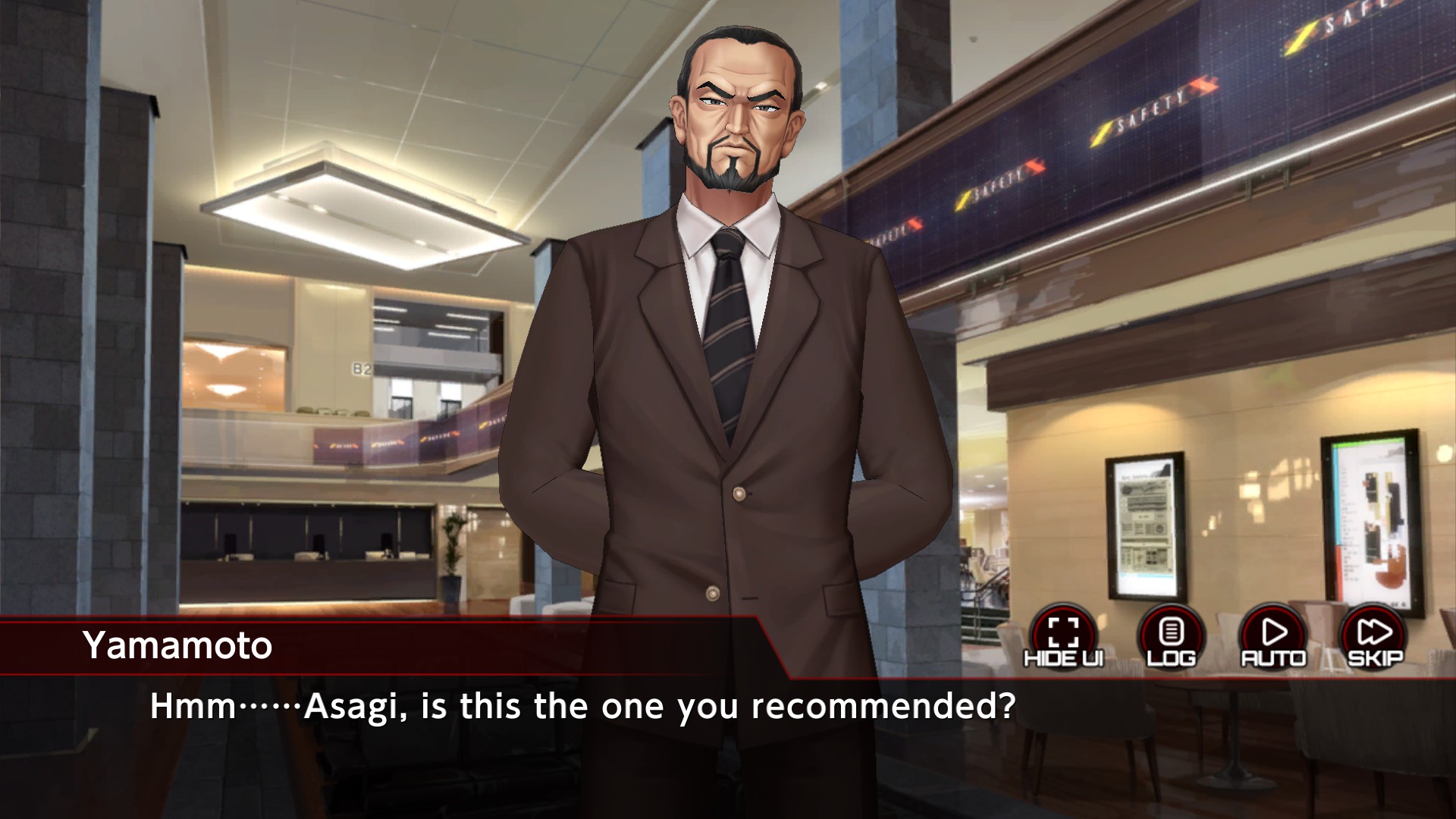
Section II: Character Development
At first, I disliked the main protagonist, but he grew on me after a while. By offering a window into his thoughts, Action Taimanin shows Fuuma Kotaro recognizes the weight of the world on his shoulders. He isn’t far removed from a stereotypical young boy with unexpected power and love interests — but he’s more than a horny character insert. As an inexperienced Taimanin Task Force Commander, he makes mistakes. But with the guidance of his team and past mistakes, he redeems himself throughout the story.
However, Fuuma Kotoro doesn’t feel necessary. Erotic offerings commonly shoehorn a male lead (catering to a predominantly male audience), but this rendition of the Action Taimanin universe is non sexual. It doesn’t need a silhouette for players to insert themselves into. If Fuuma’s role as Commander were supplanted by Igawa Asagi, the story would be unchanged. After all, Fuuma literally never participates in battle; he is never seen nor directly controlled by the player. As a battled-hardened veteran, it would make perfect sense for Asagi to provide the same cunning and exposition as Fuuma.
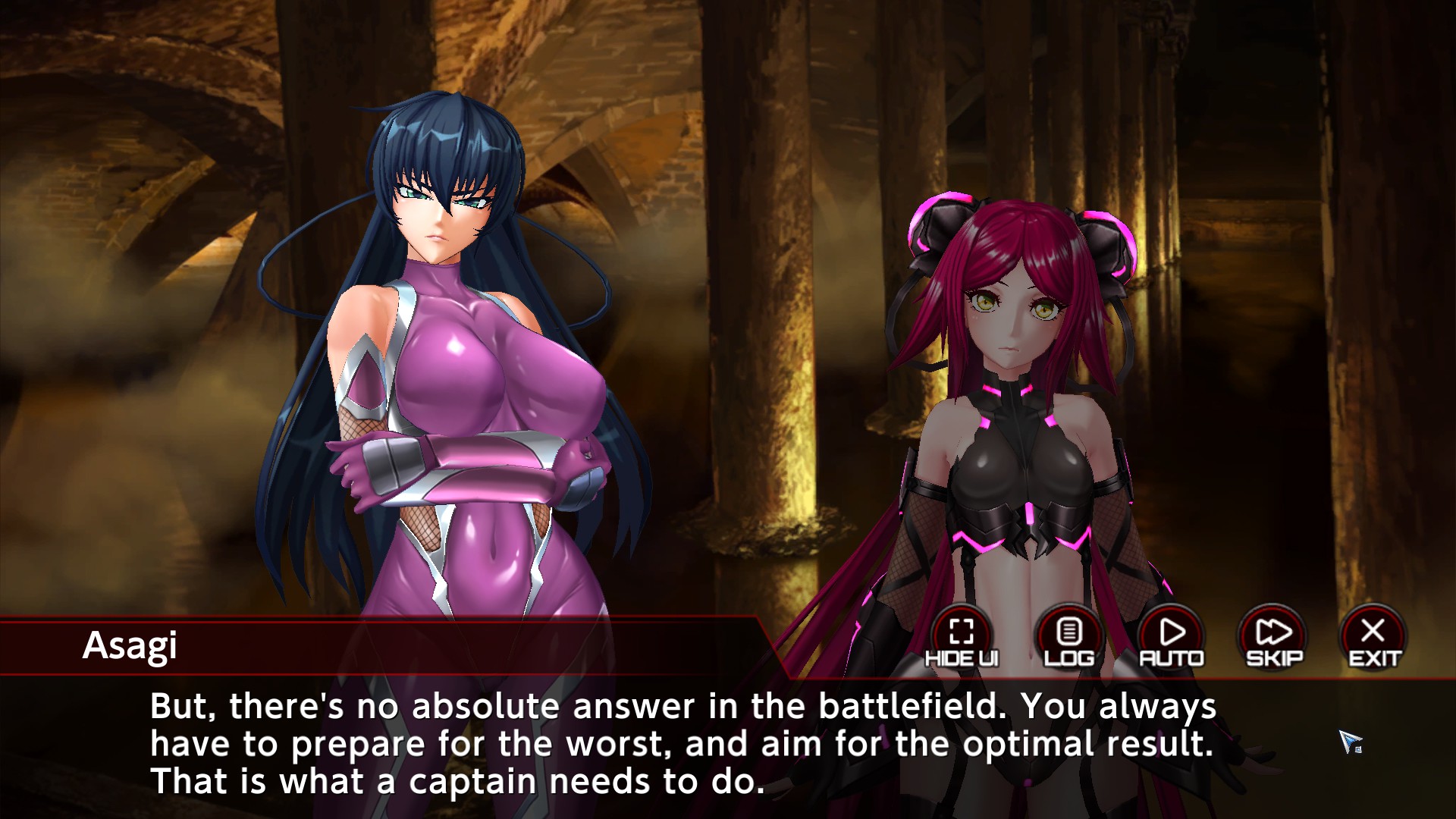
Sound (3/5★)
Section I: Voice Acting
Action Taimanin is fully voiced in Japanese! I only know one word — konnichiwa! I can’t vouch for the quality of acting, but the audio was clean and professional. I enjoyed listening to dialogue while reading English subtitles.
Unfortunately, gameplay was short ended on acting. Taimanins only have a handful of lines for combat — in less than a minute, they will already be recycling voice clips. Action Taimanin expects players to login and grind multiple times daily. It’s bothersome to hear such a weak selection of dialogue while fulfilling daily obligations.
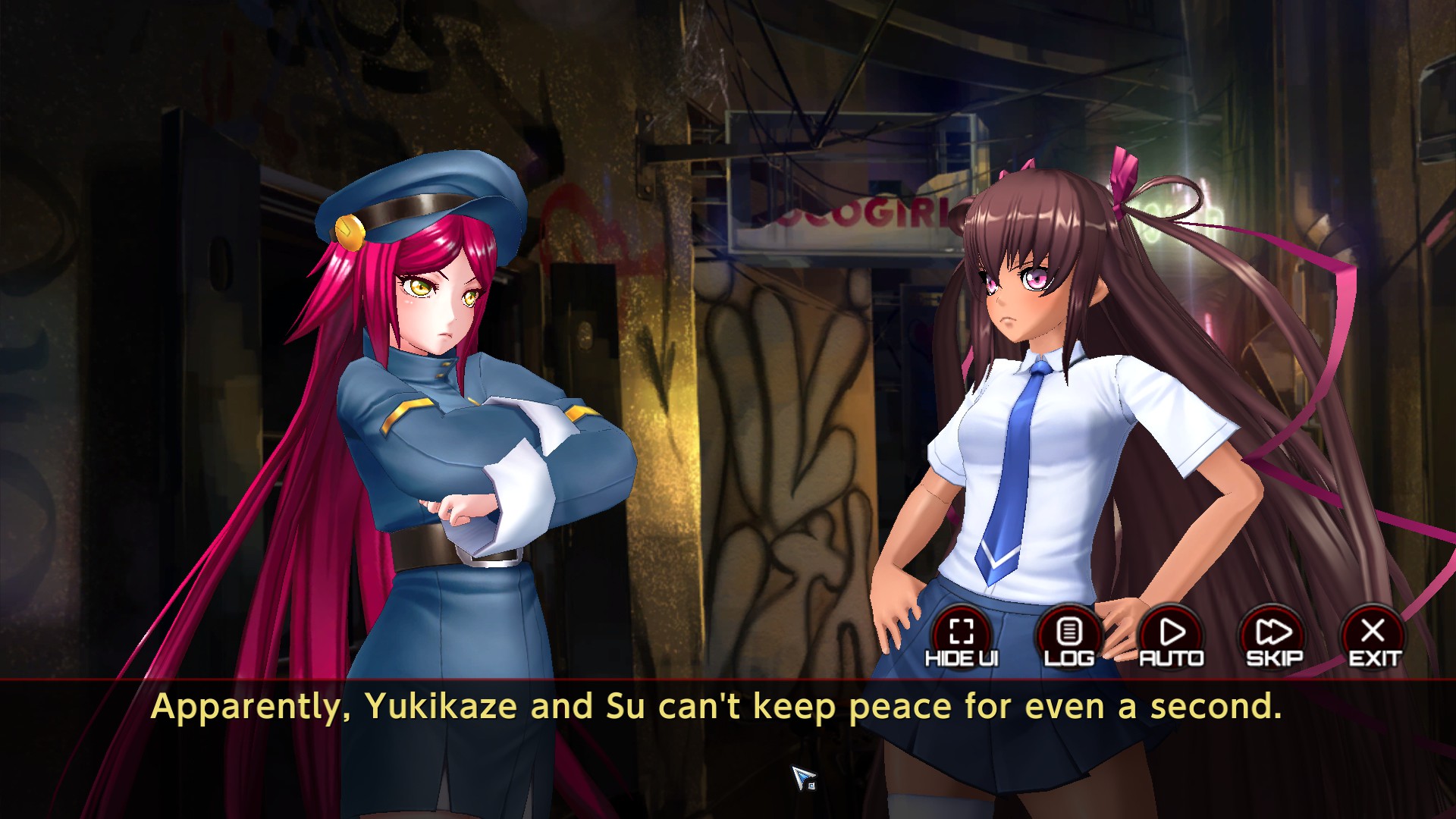
Seed of the Dead: Sweet Home is a lewd shooter with a better handle on combat dialogue. The protagonists provide ongoing commentary, including cheers, encouragement, and requesting cover.
In my original review for Seed of the Dead: Sweet Home I wrote, “I loved the ongoing commentary your party provides; whether they’re kicking ass or reloading, it makes destroying Z’s shoulder-to-shoulder more satisfying.”
Although Action Taimanin doesn’t offer squad-based combat, it’s a missed opportunity to have owned Taimanins and equipped Supporters to react to gameplay. In fact, they could speak directly to the player; although players control Taimanins, the player character and main protagonist is Fuuma, Taskforce Commander. Issuing commands from afar, Taimanin dialogue towards the player could maintain Fuuma’s role as Commander.

Section II: Soundtrack
Action Taimanin has kickass soundtrack! Unfortunately, every Quest and game mode is assigned one track only. Considering Action Taimanin is mostly PvP and grinding one of four “Daily Quests”, the “kickass soundtrack” is guaranteed to go stale. Ultimately, I dealt with Action Taimanin‘s repetitive music with a Spotify subscription.
The most egregious case of musical monotony belongs to the “player hub”. It features one tune where players will spend the most playtime outside of Daily Quests. One can spend hours collecting rewards, managing inventory, upgrading Taimanins, and participating in gachas from within the player hub. It’d be nice to have a radio.
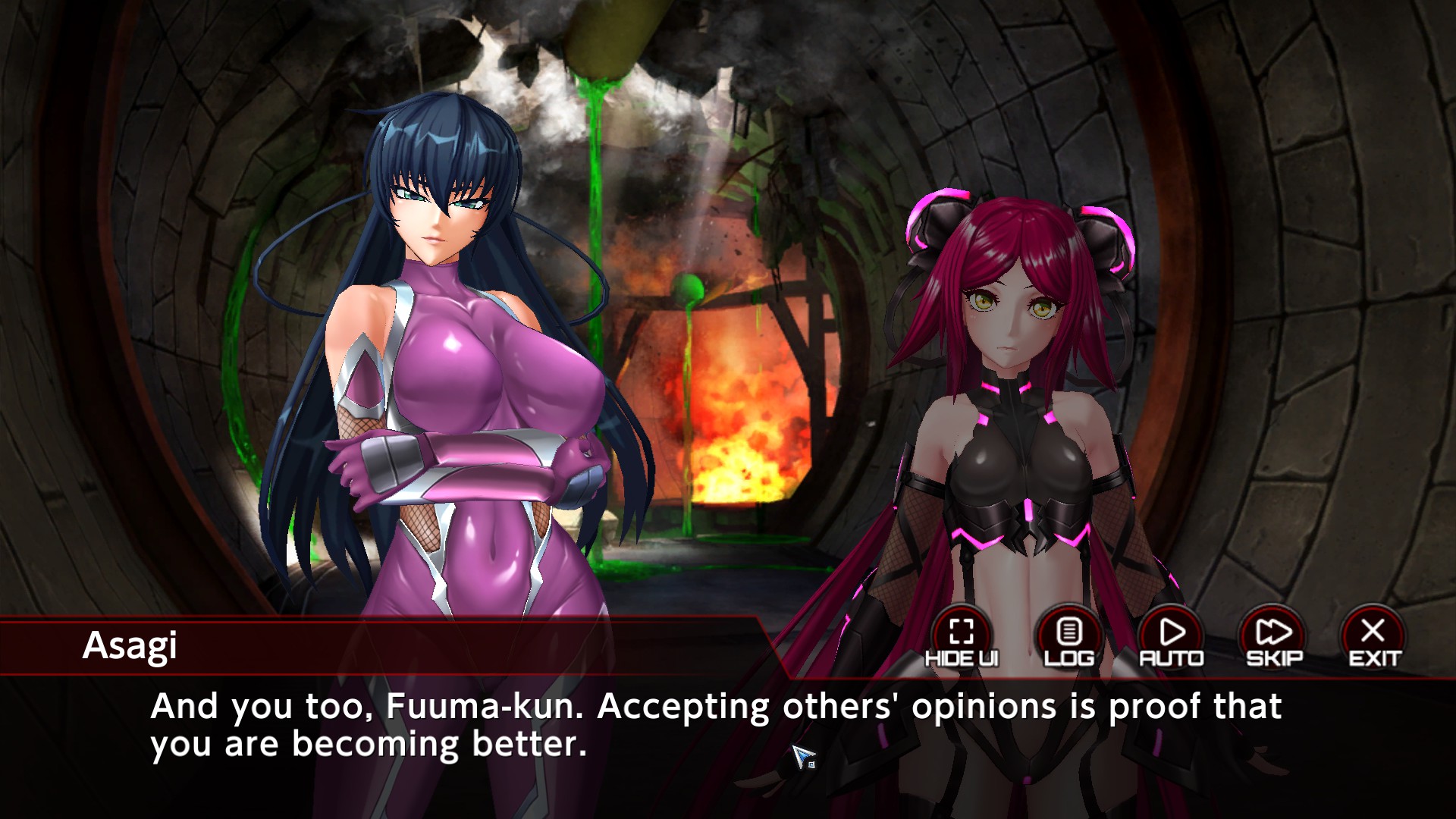
Chapter V: Visuals (3/5★)
Section I: Graphics
When discussing Action Taimanin‘s graphics, keep in mind the Steam release is a mobile port. From what I’ve observed, there does not appear to be any graphical improvements between the Android and Steam version of the game. On the fifteen-inch screen I used to play this game, the limitations of mobile devices show. Models have sharp edges with pixelated textures, and visual effects are flat, blurry and generally unimpressive.
The character roster of Action Taimanin is a mixed bag. Between generic zombies, ninjas and sci-fi troopers, enemies look as though they were pilfered from another game. They hardly resemble the playable cast of scantily clad Taimanins. They don’t even share the same body or facial proportions! Clearly, there was a disconnect between LiLith‘s artists — I have a feeling at least some of the assets were poorly outsourced.
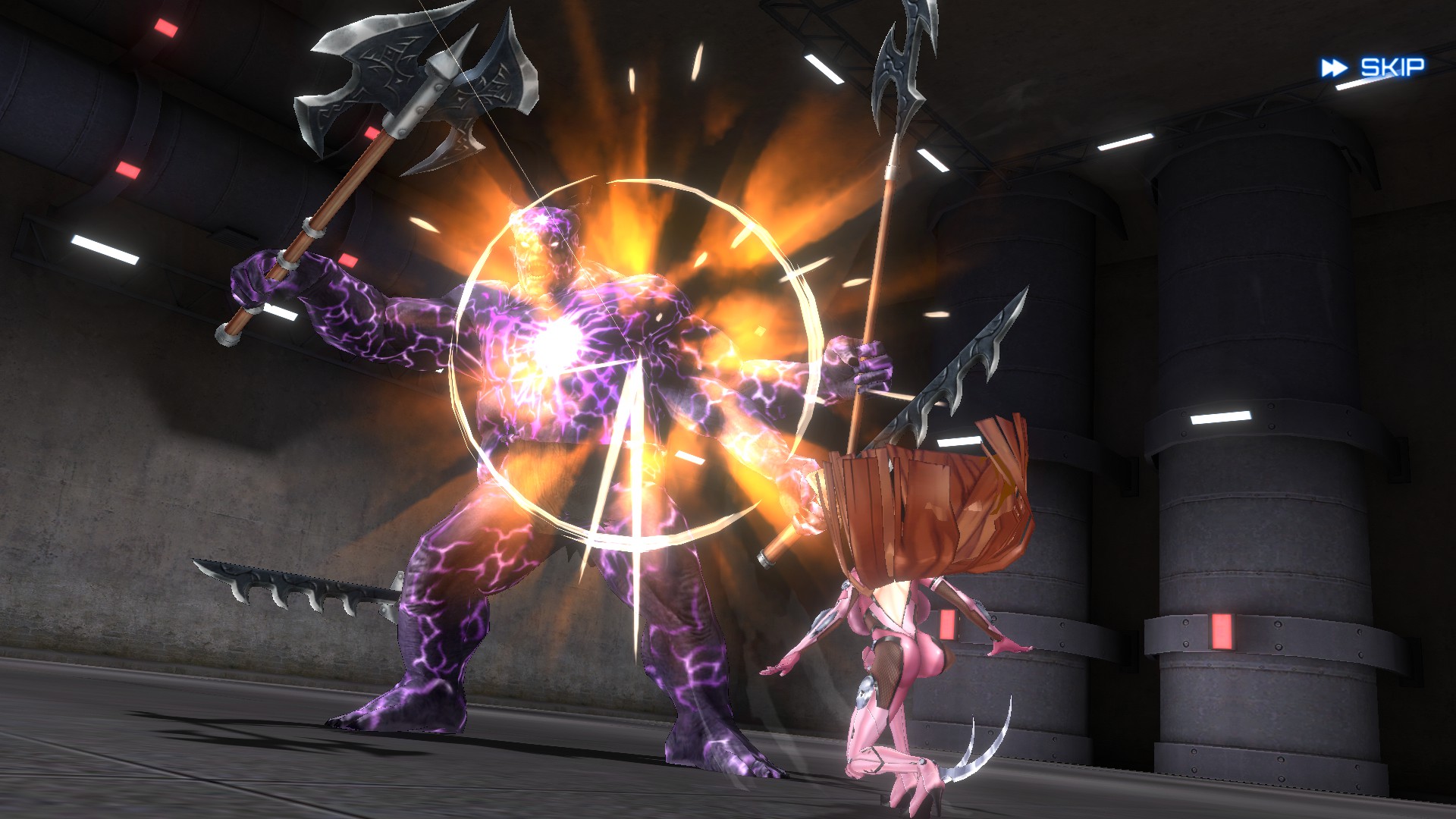
Dialogue and exposition are typically delivered using a visual-novel format. Characters are represented by animated, 3D avatars rendered over a backdrop. Most of them seem to be hand drawn, though a few of them appear to be retouched photos. It’s hard to tell, but in any case they are an aesthetic disconnect. These backdrops are more appropriate for a traditional visual novel, with hand-drawn characters and backgrounds.
My favorite backgrounds were the ones that showed playable sets. Taimanins look best in their element! Action Taimanin‘s models may not be as detailed as paintings (or photographs), but they do a better job maintaining suspension of belief. I hated to be shown places that didn’t exist in-game. Unfortunately, LiLith is probably more interested in designing cosmetics for big spenders than improving the core game for everyone else.
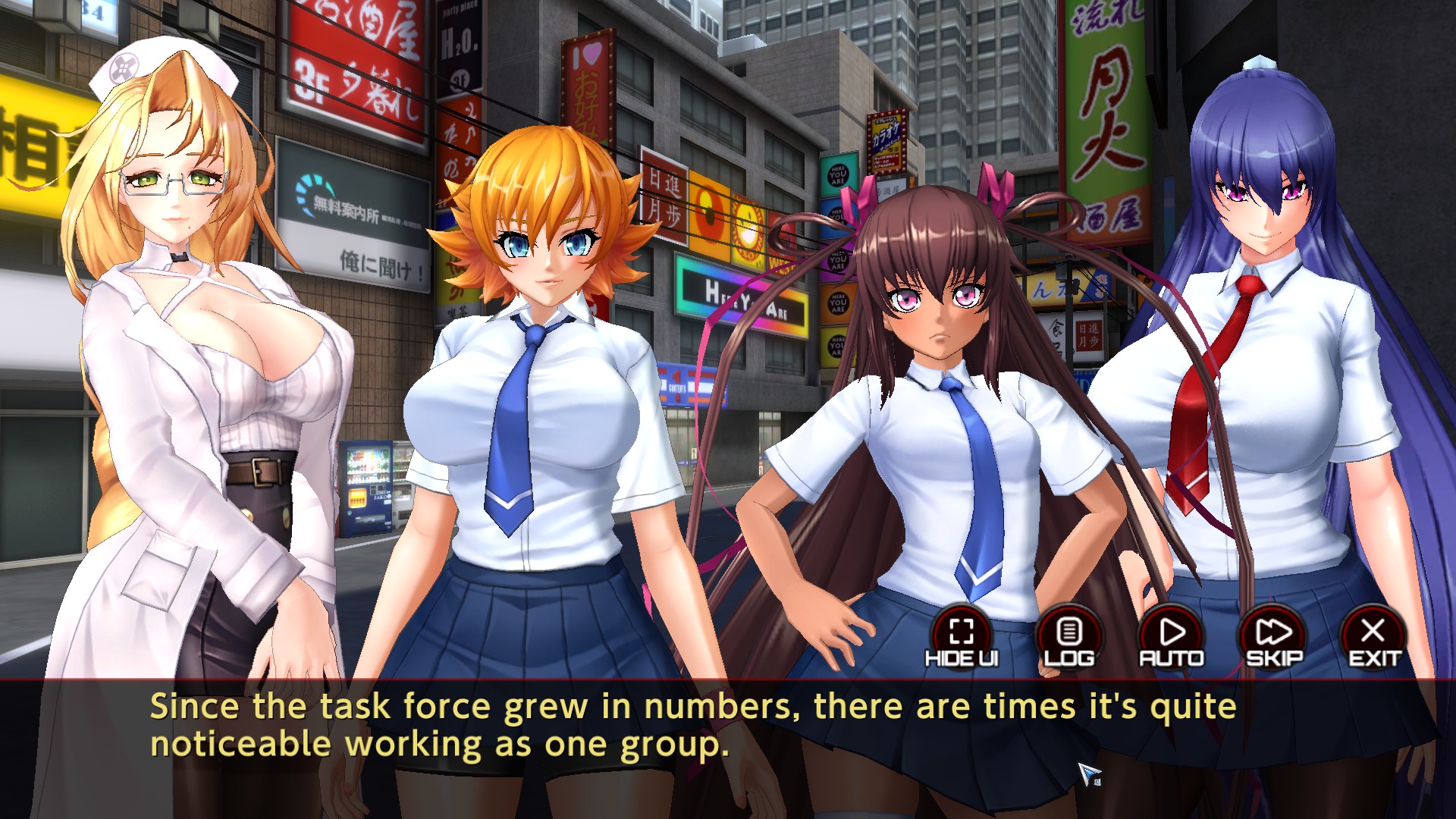
Section II: Customization
Character customization is limited to premade “Costumes” and randomized pallete swaps. Costumes range in price between 150 and 300 Gems, or as much as ten dollars (depending on where you buy your Gems). However, not all Costumes may be purchased using Gems; they instead cost thirty-two dollars. These costumes are strictly for sale for a limited time — reaffirming “LiLith is not above “fear of missing out” (FOMO) offers”.
Each Costume has at least two predefined colorations and one or more toggleable options. Using “Phantasmal Dye”, you may edit the colors palletes of select outfits. There’s just one catch: colors are randomized, and you must pay increasing amounts of Dye to preserve the colors you want to keep while rerolling for others. Phantasmal Dye is inexpensive (about a Gem each), but the system is wholly designed to prey upon players. What ever happened to be able to just choose the colors you want?
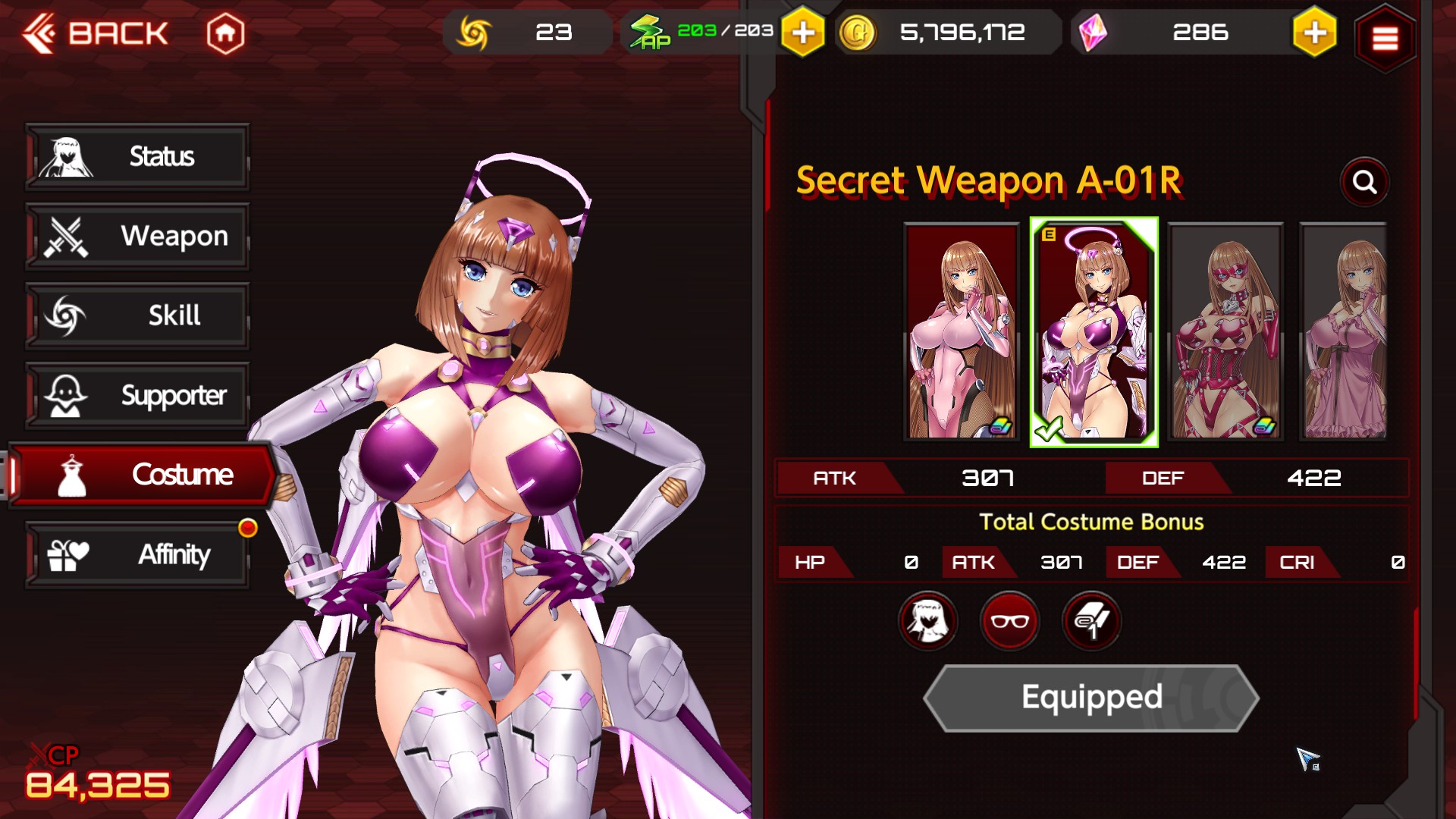
Chapter VI: Verdict (2.5/5★)
Action Taimanin was a daunting game to review. As a “freemium” experience, this game is a confusing mess of currencies, gachas, timers and microtransactions. Setting aside the bullshit, it’s. . . okay I guess. Action Taimanin offers a comprehensive (but currently incomplete) campaign with hours of voiced dialogue. The hack-and-slash gameplay is a little monotonous, but you’re able to play through many hours of content before encountering paywalls. But after completing the story Action Taimanin shows its true colors; what awaits are hundreds of hours of grinding, timers and monthly bills to keep up with biweekly FOMO offers and events. Action Taimanin is worth playing once or twice as a free introduction to the universe — but it’s far too expensive to get invested into.
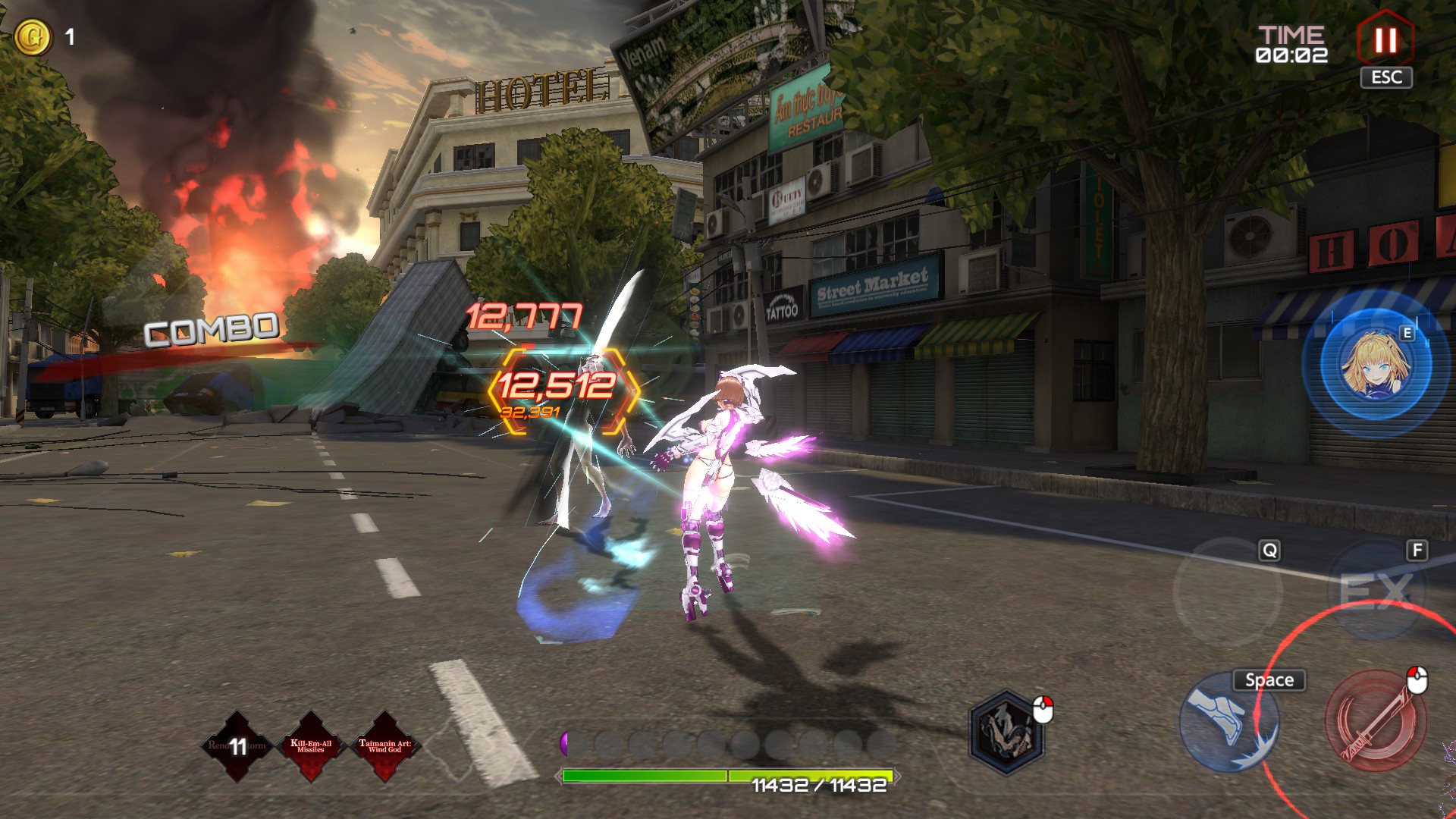
Epilogue: Recommendations
Section I: Pricing
Action Taimanin‘s prices are outrageous — it costs thousands yearly to keep up with limited time offers. New characters really shouldn’t cost as much as much as a new videogame. The “Private Room” should be completely free, and it shouldn’t cost money to change the color of outfits. If LiLith reduced all of their prices by at least 50%, they’d be. . . more reasonable. I think players would be willing to pay up ten or fifteen dollars for new Taimanins and Packages, which include cosmetics and equipable items.
Section II: Invulnerability in PvP
Invulnerability must be dramatically reduced in strength, if not outright removed in PvP environments. Players with access to invulnerability create a gap virtually impossible for new players to cross. It costs hundreds, if not thousands of dollars to acquire the necessary Supporters from Gachas or the Mileage Shop to compete. Supporters such as Amamiya Shisui and Kuonji R. Spica are great for difficult PvE content (such as the Arena Tower), but they have no place in the Battle Arena. As long as they remain unbanned (or unbalanced), they will continue to punish players for equipping any other Supporters.
